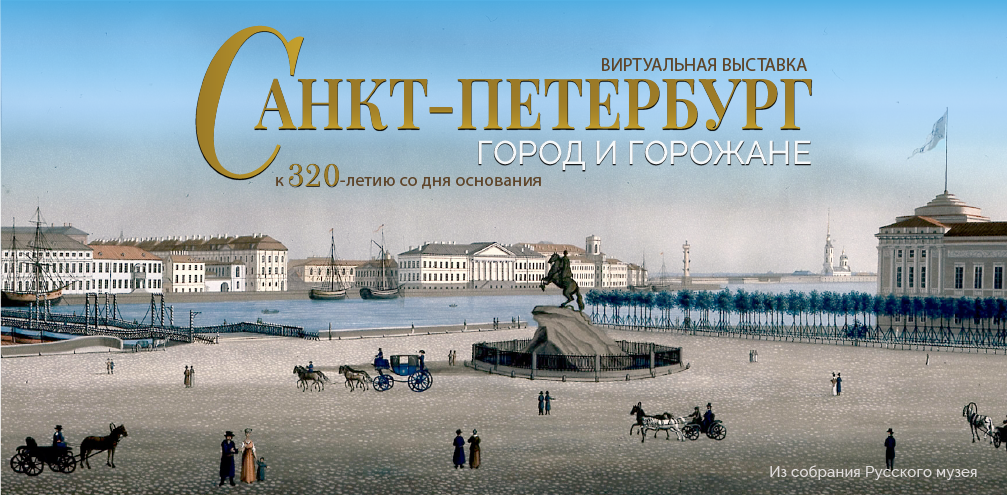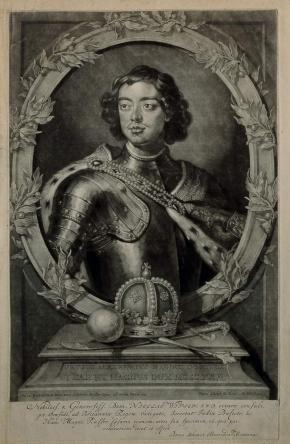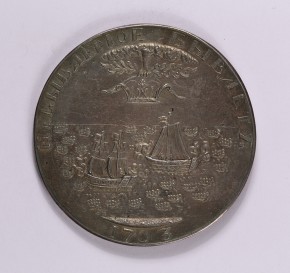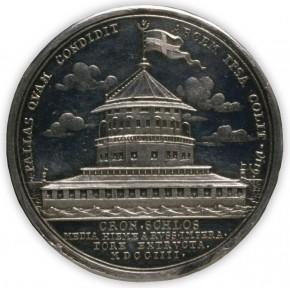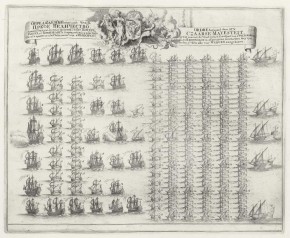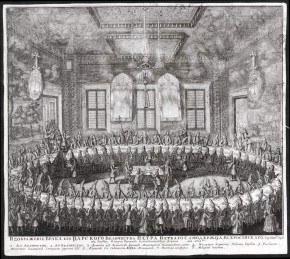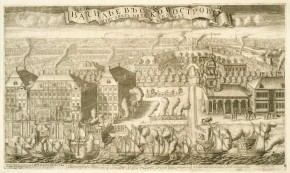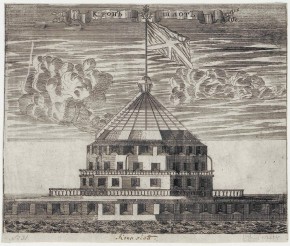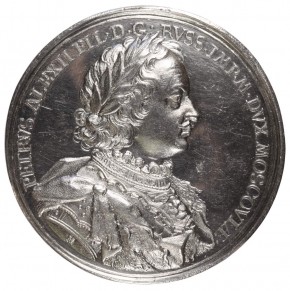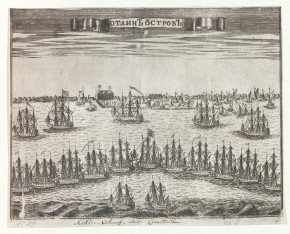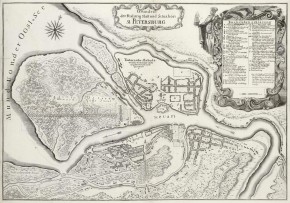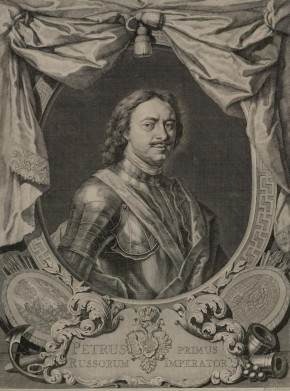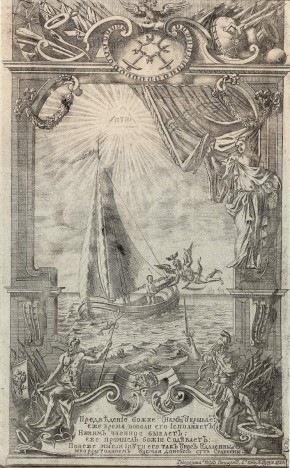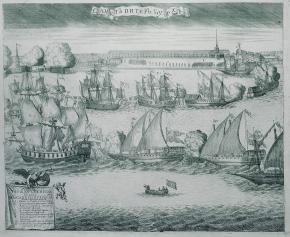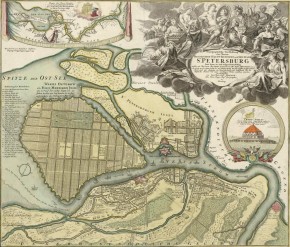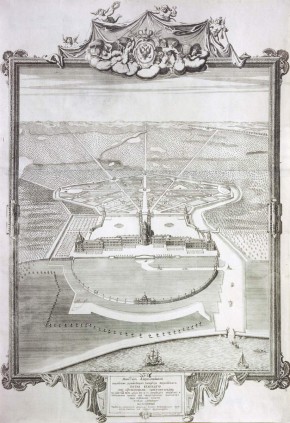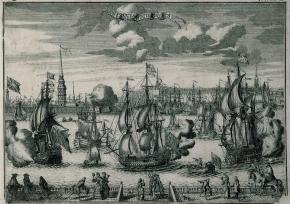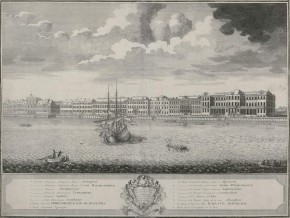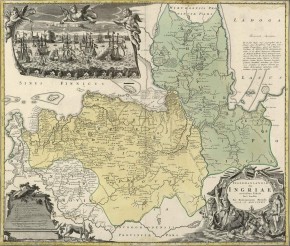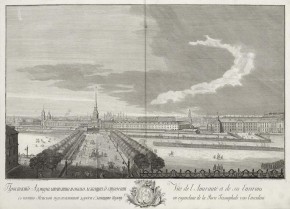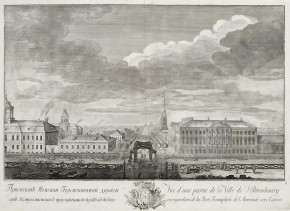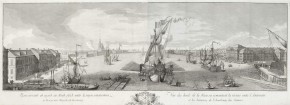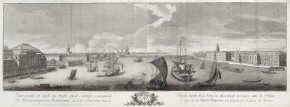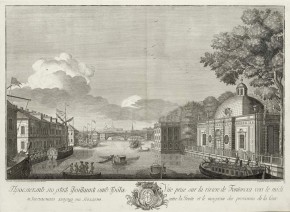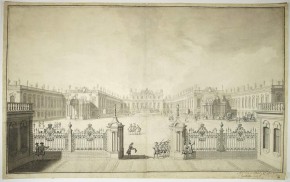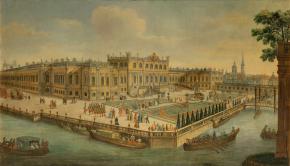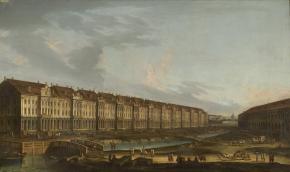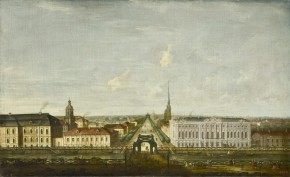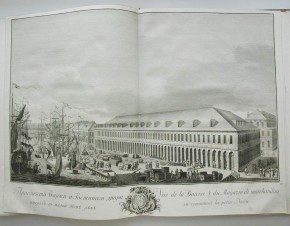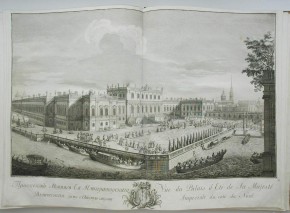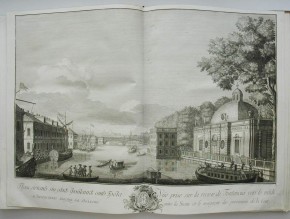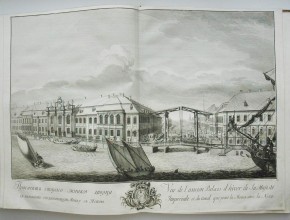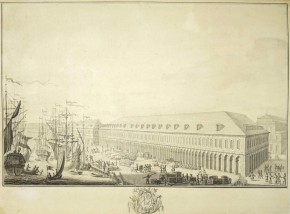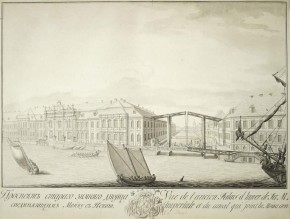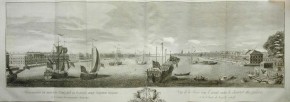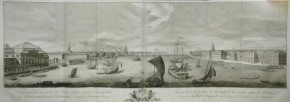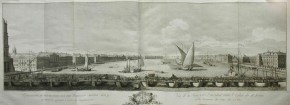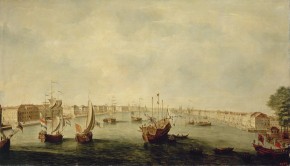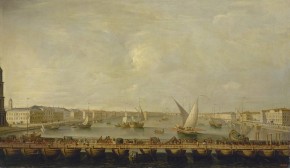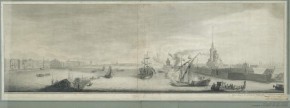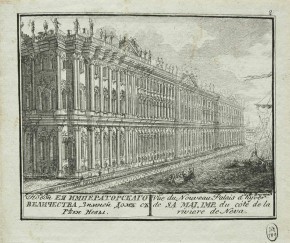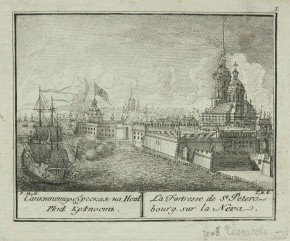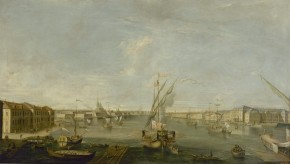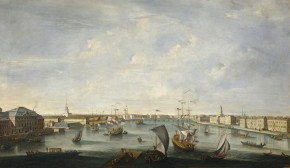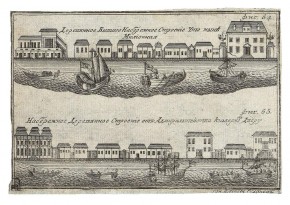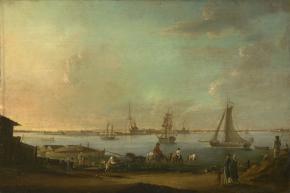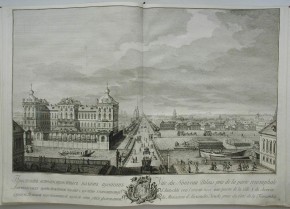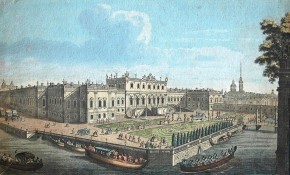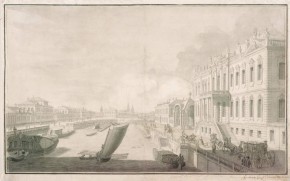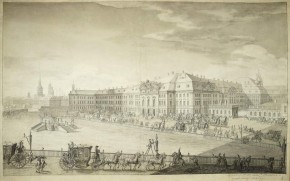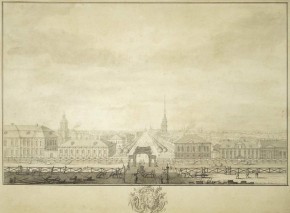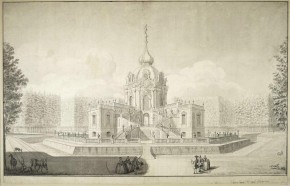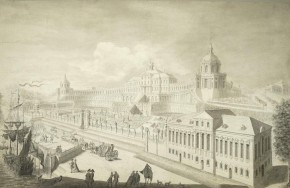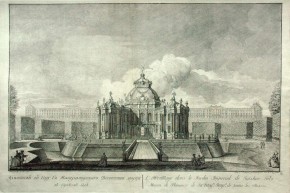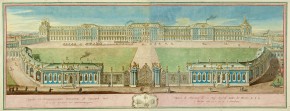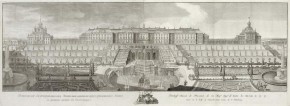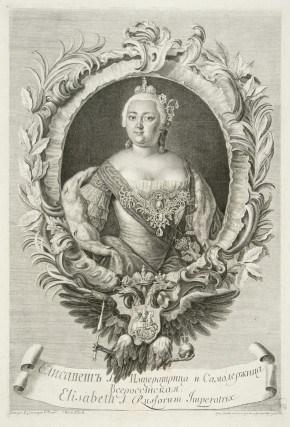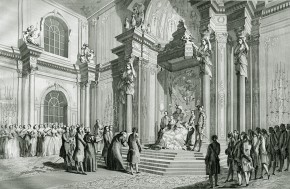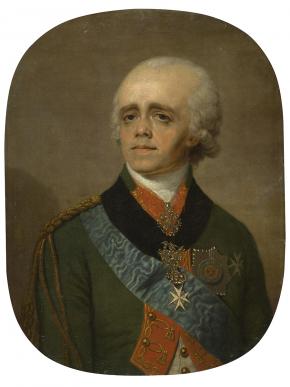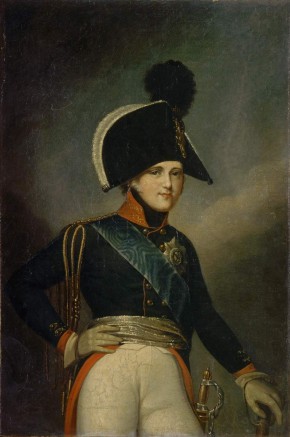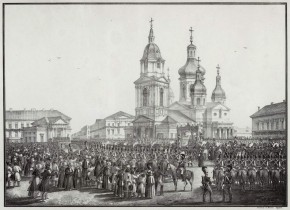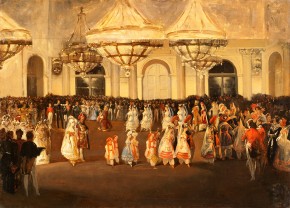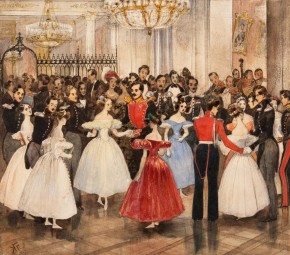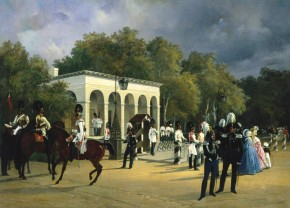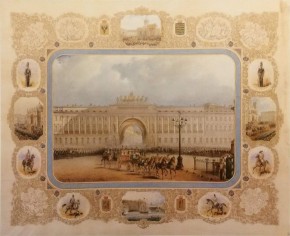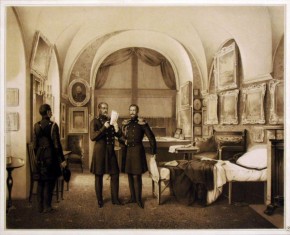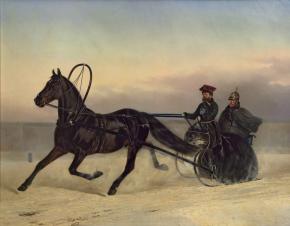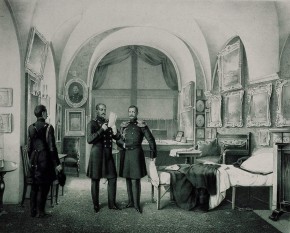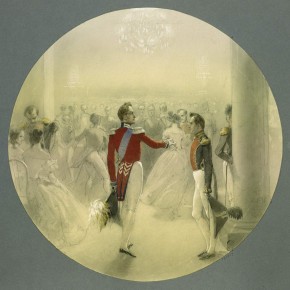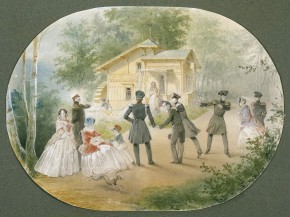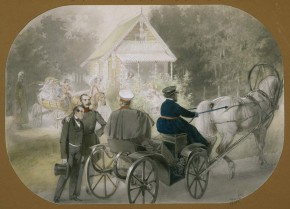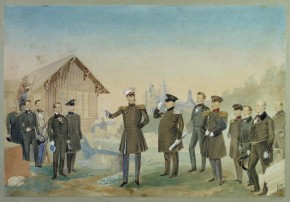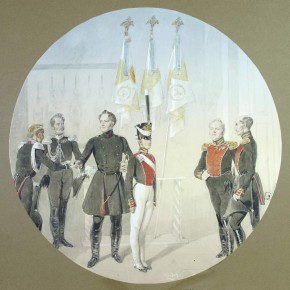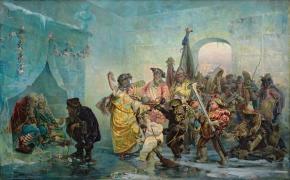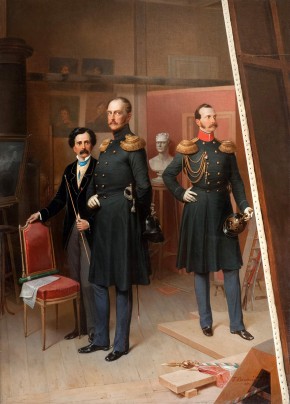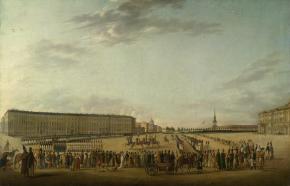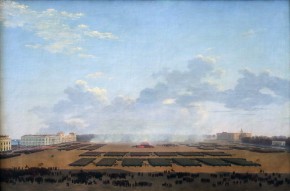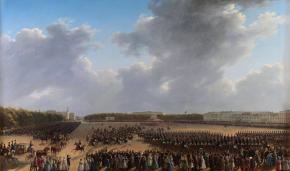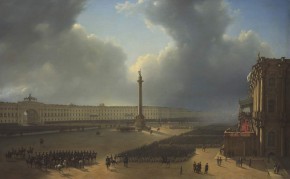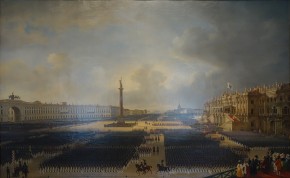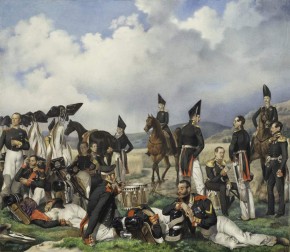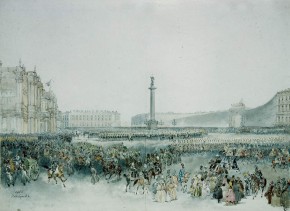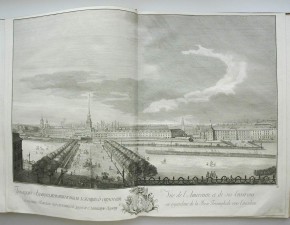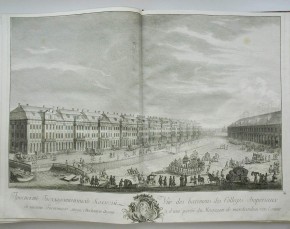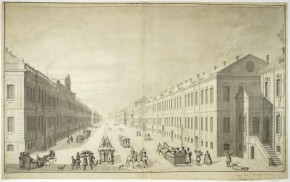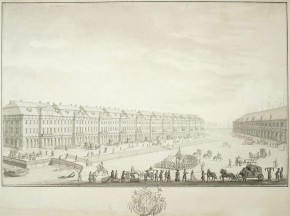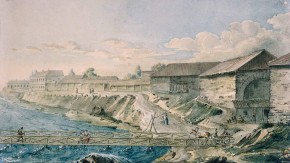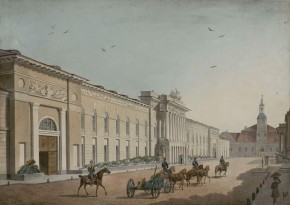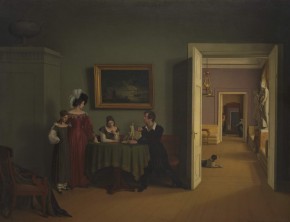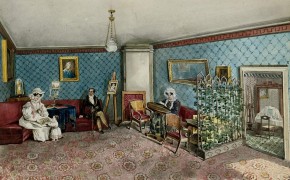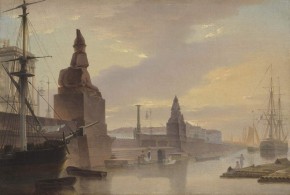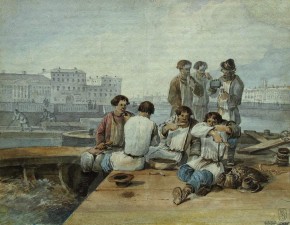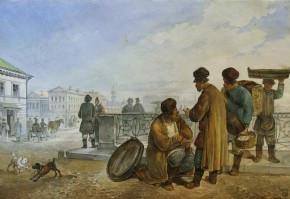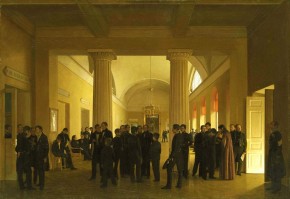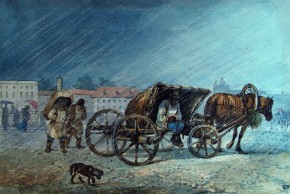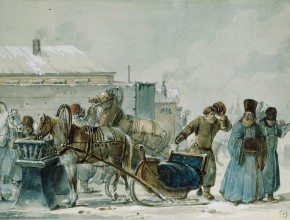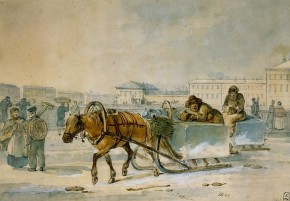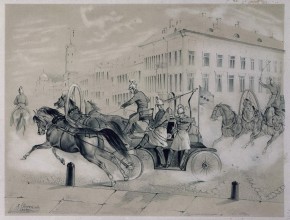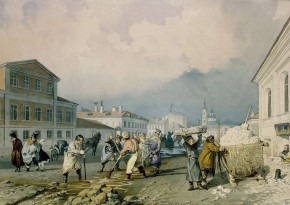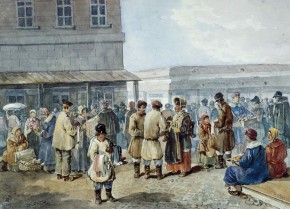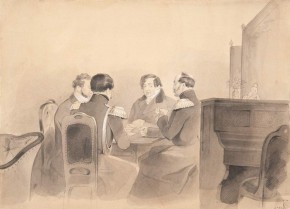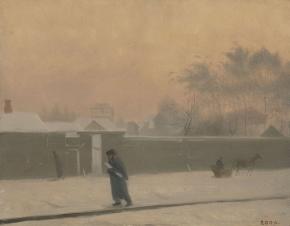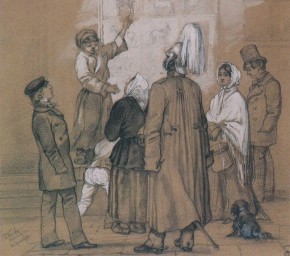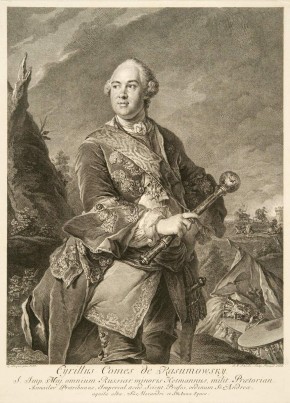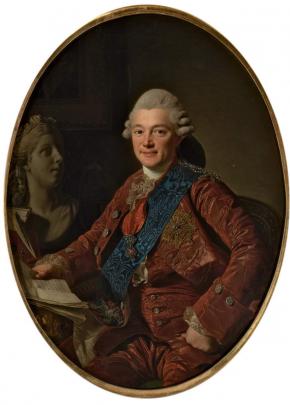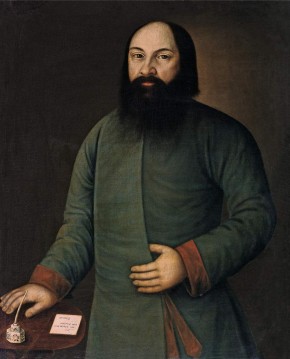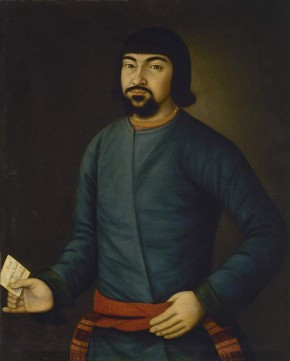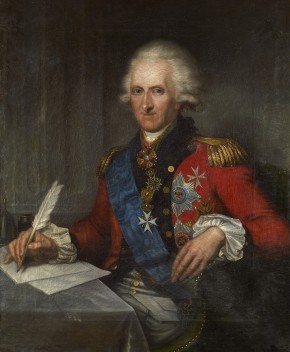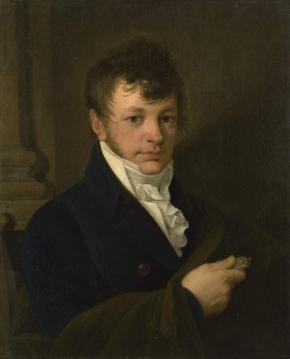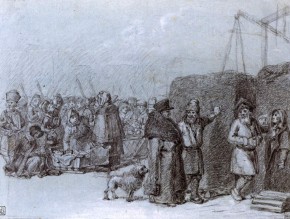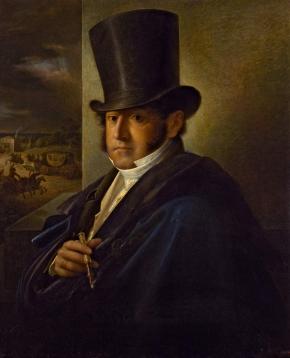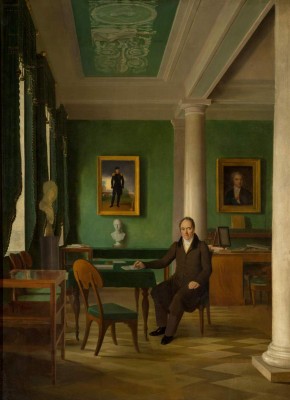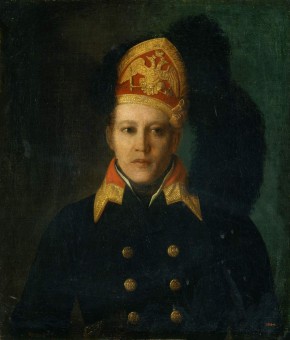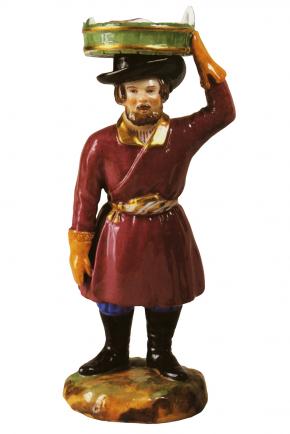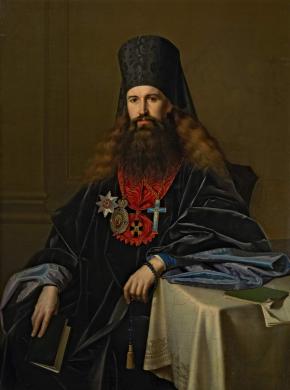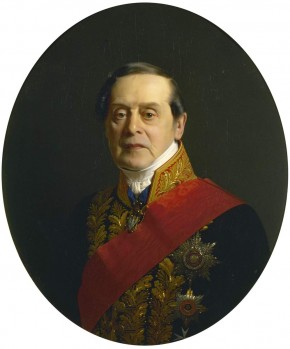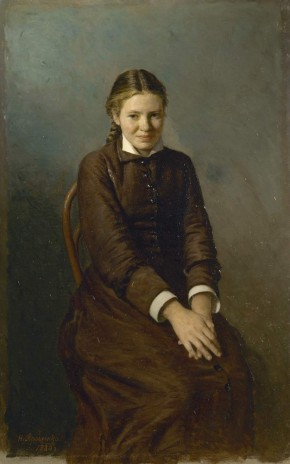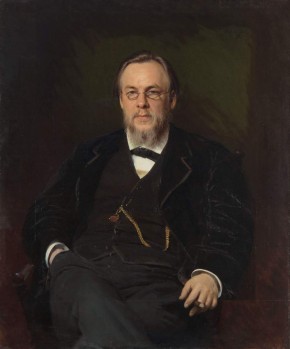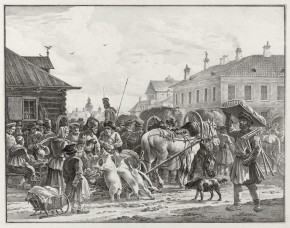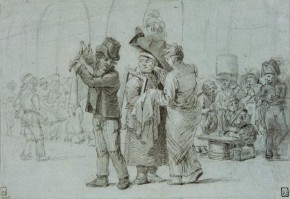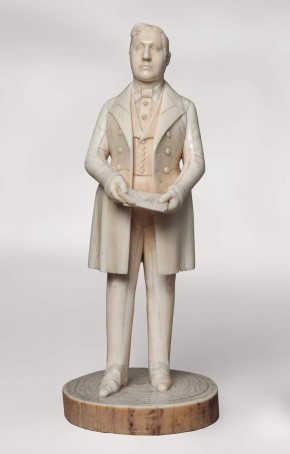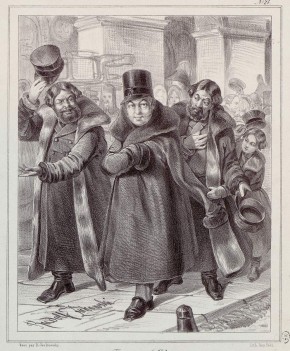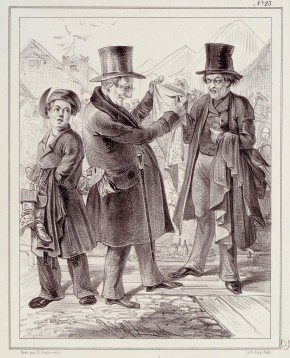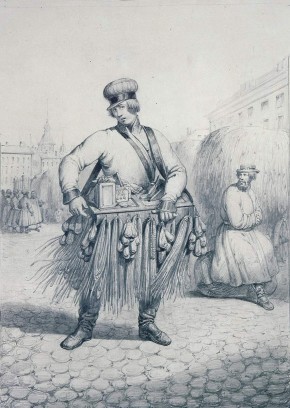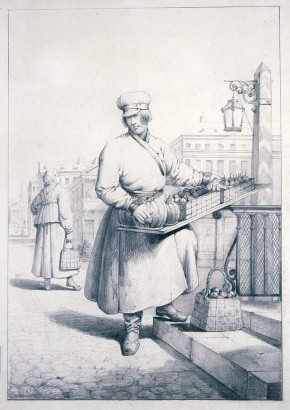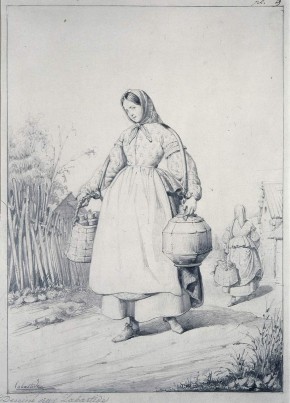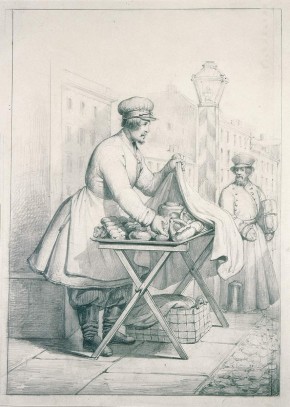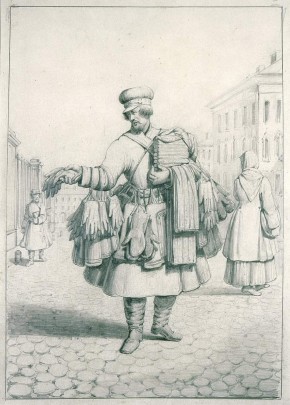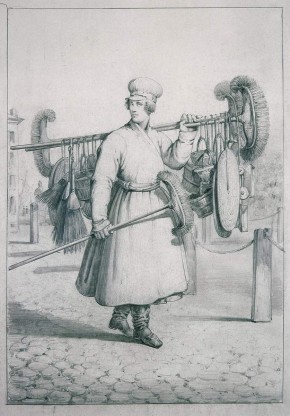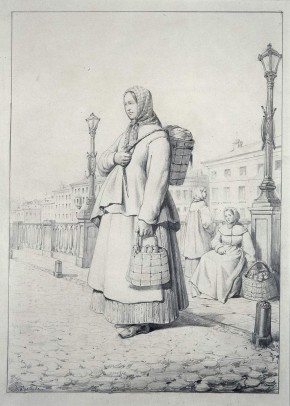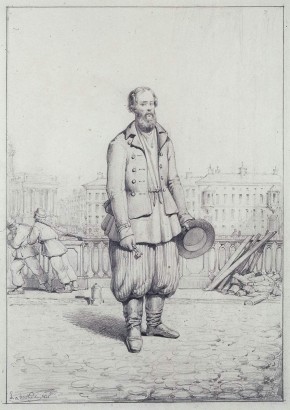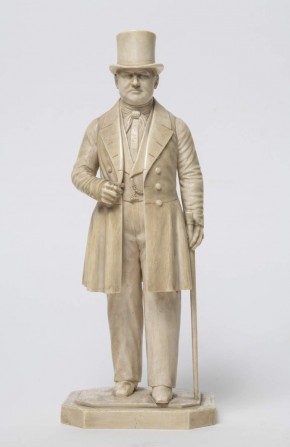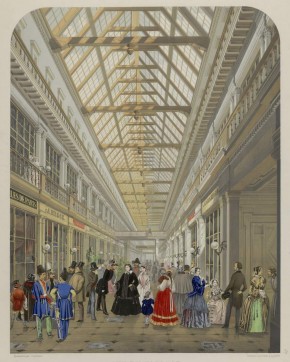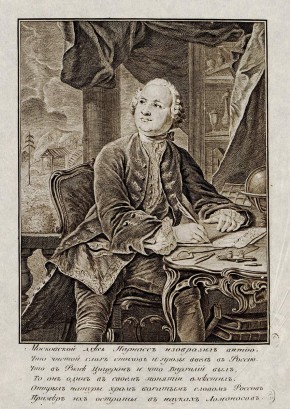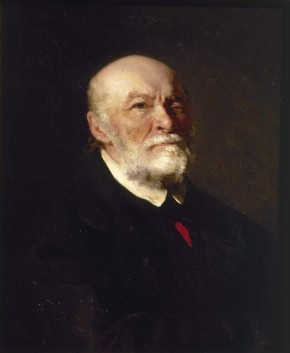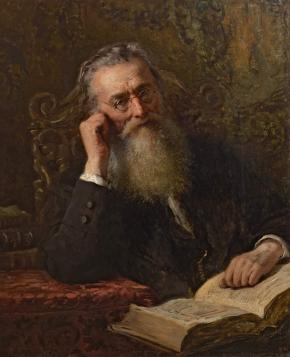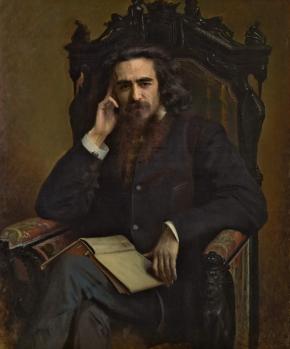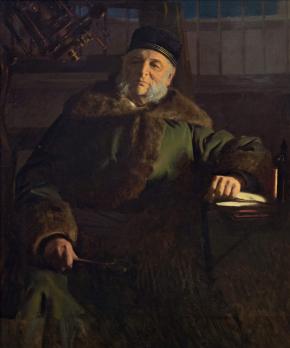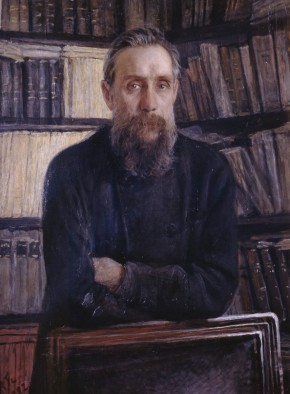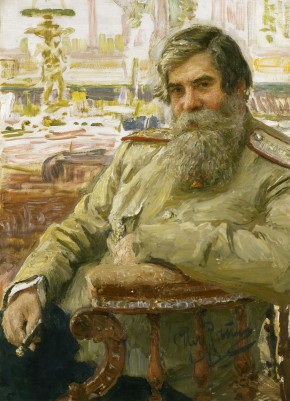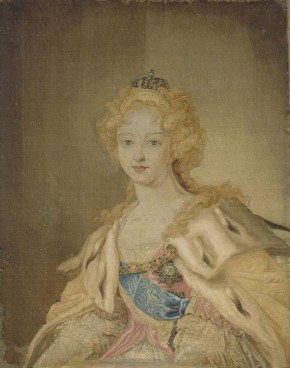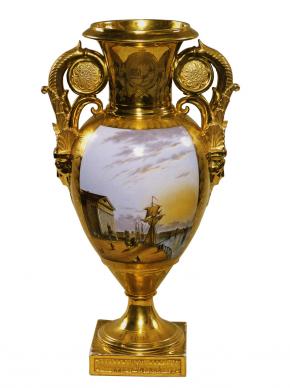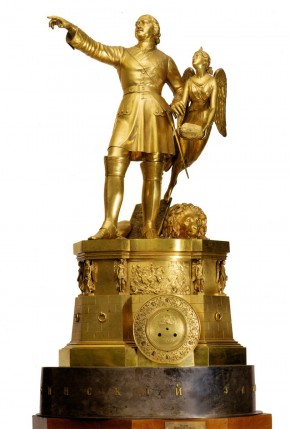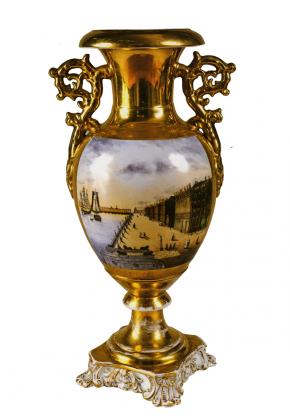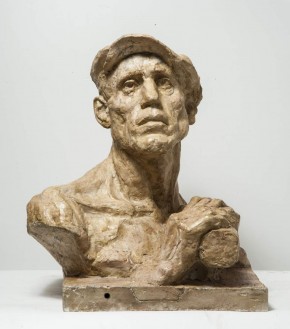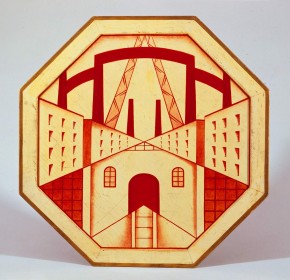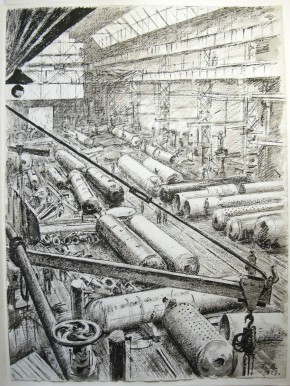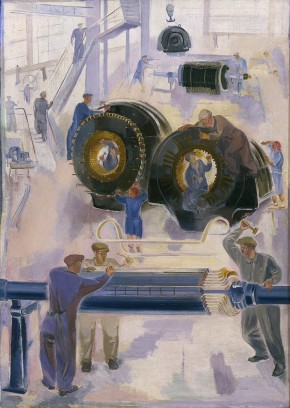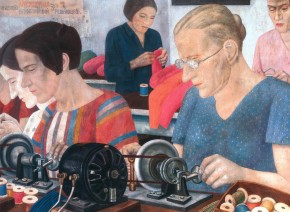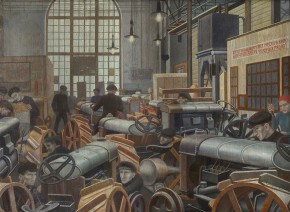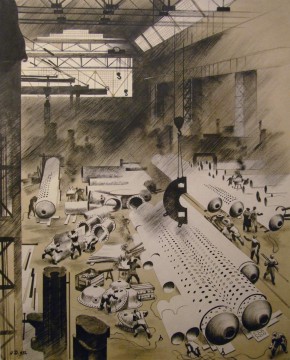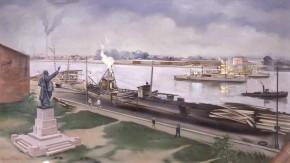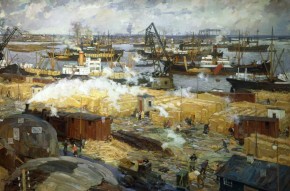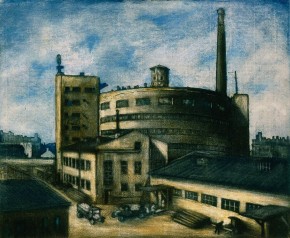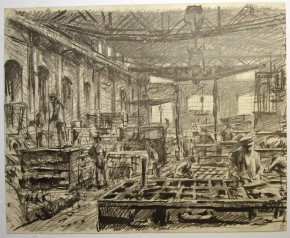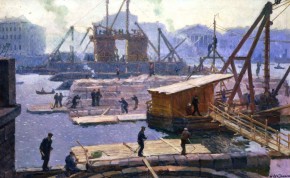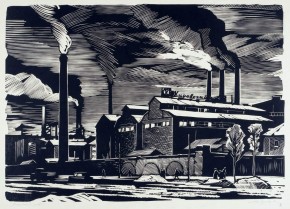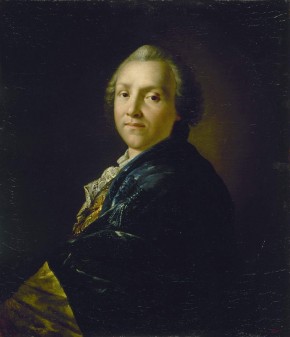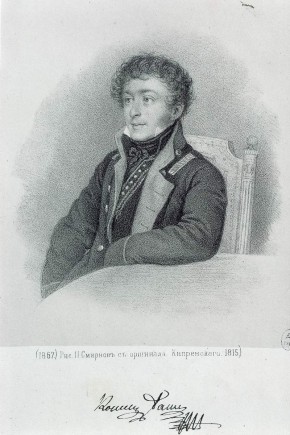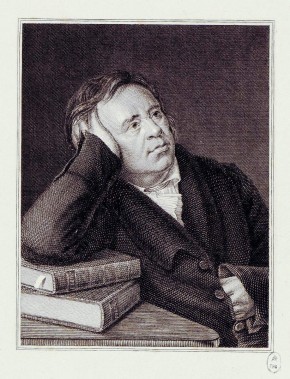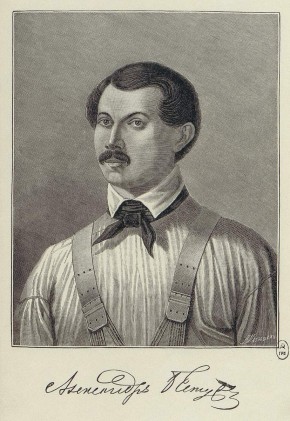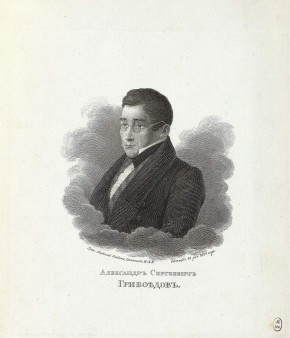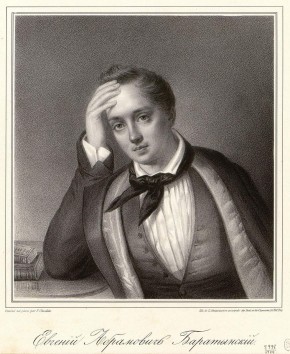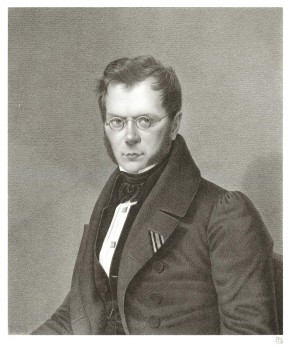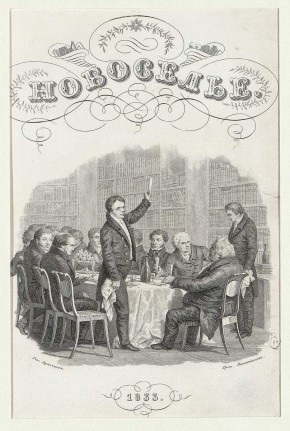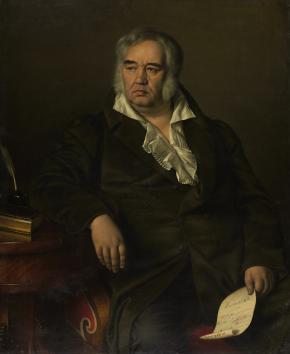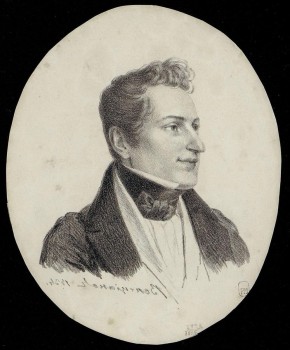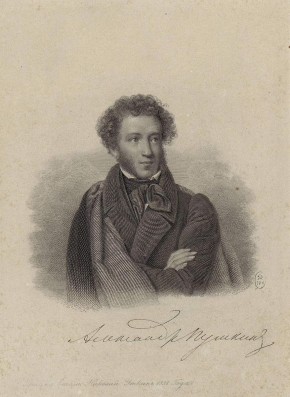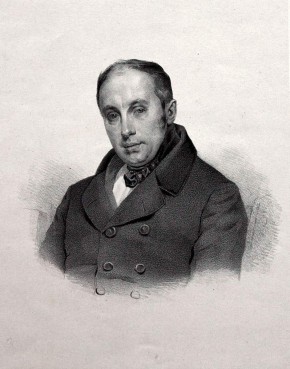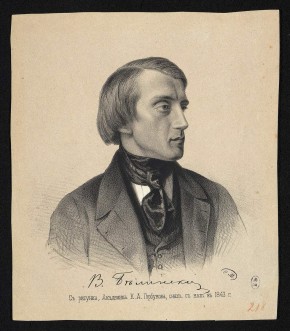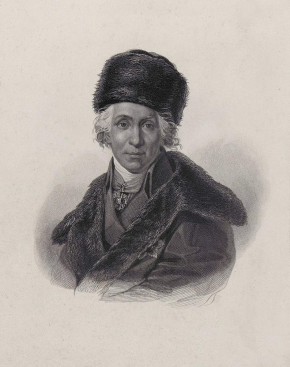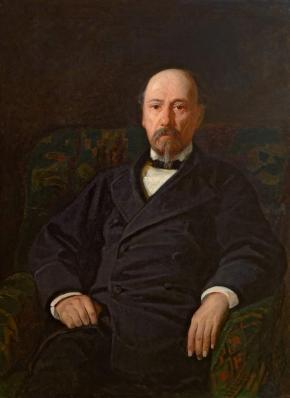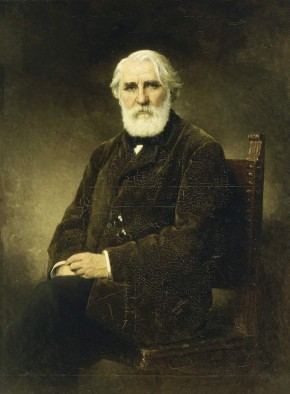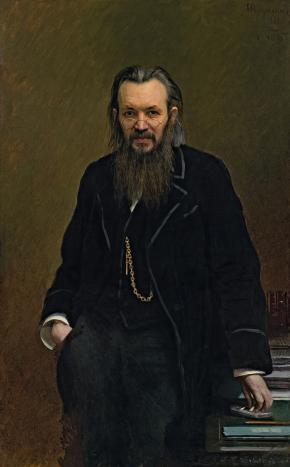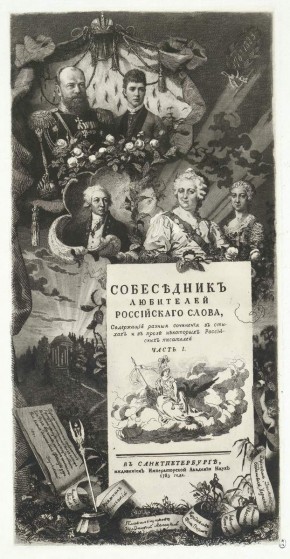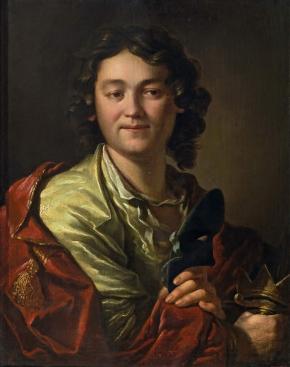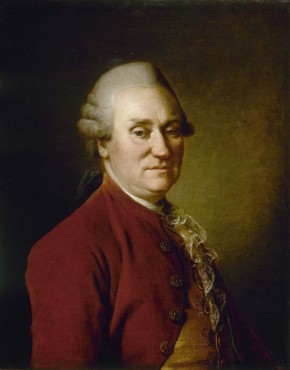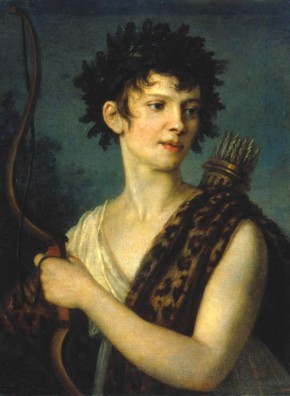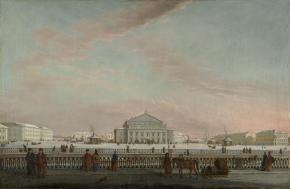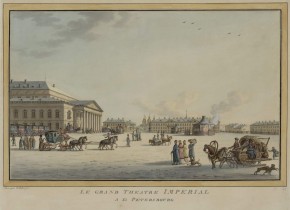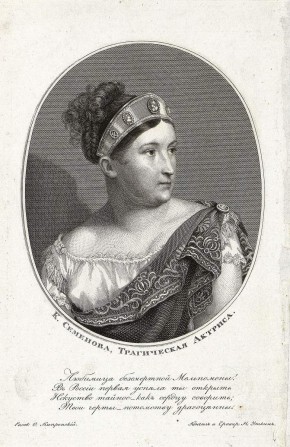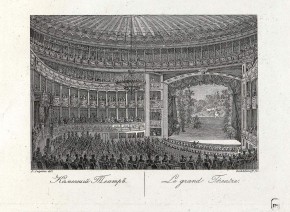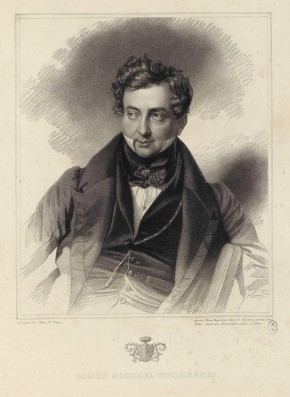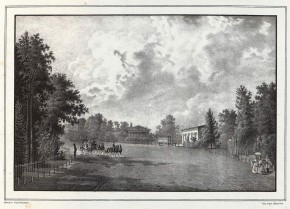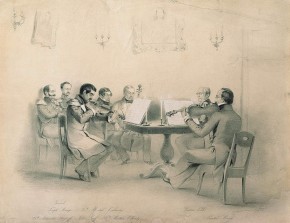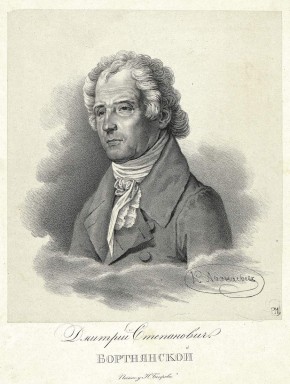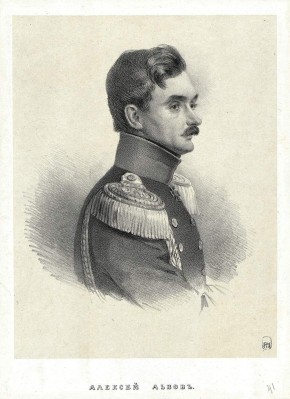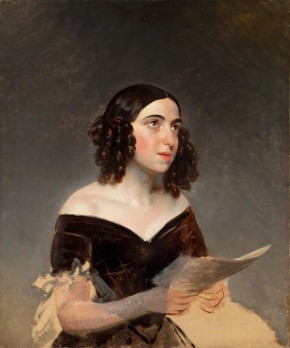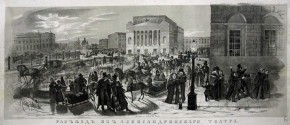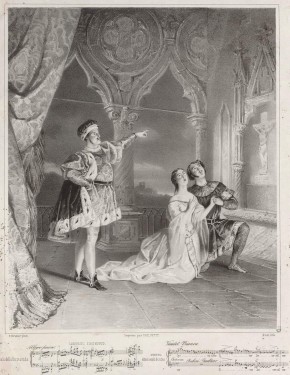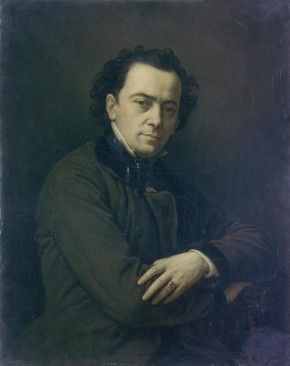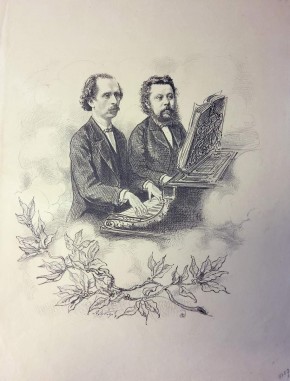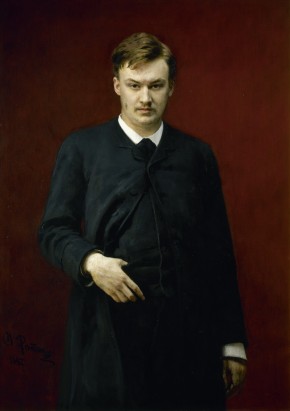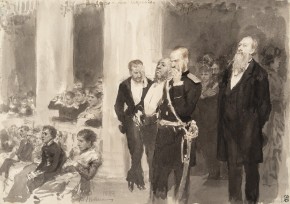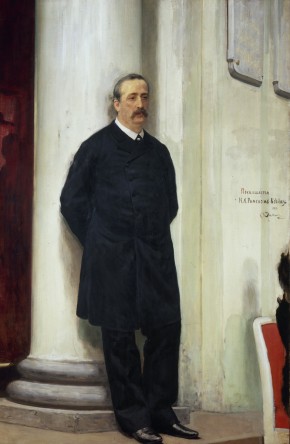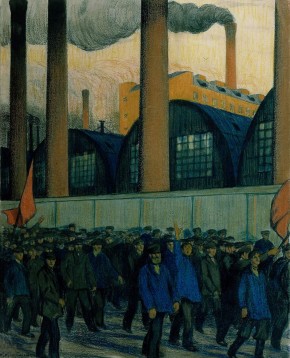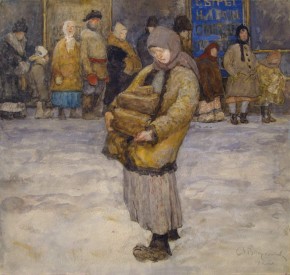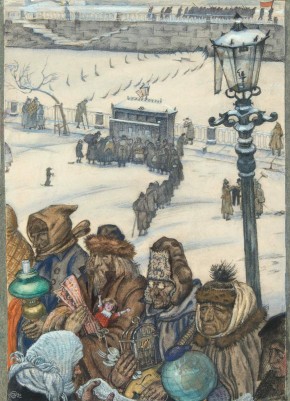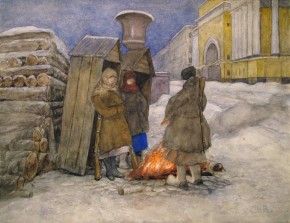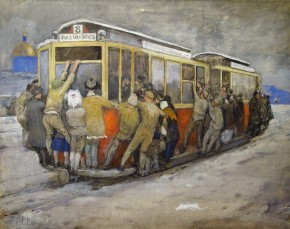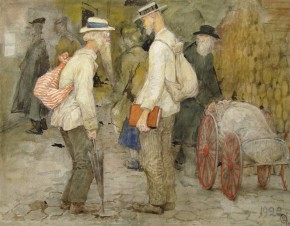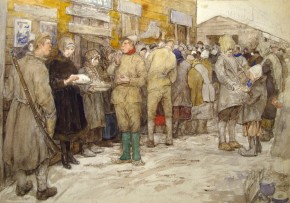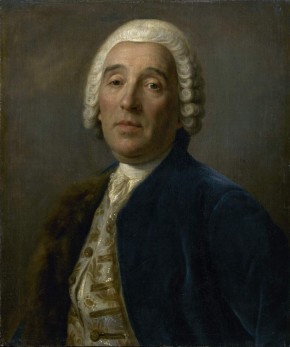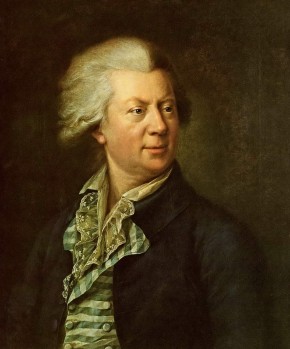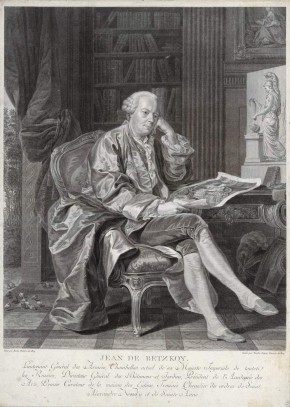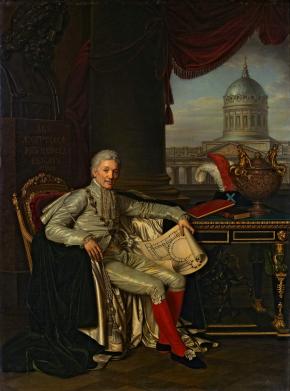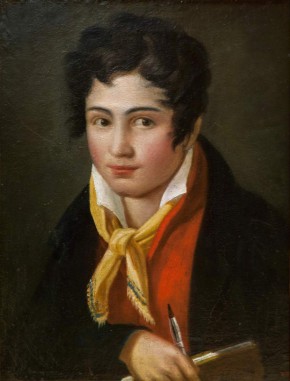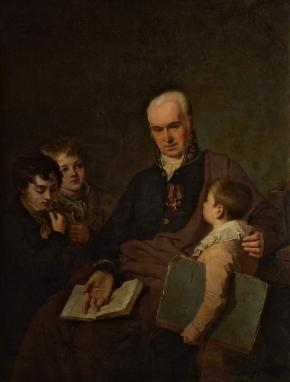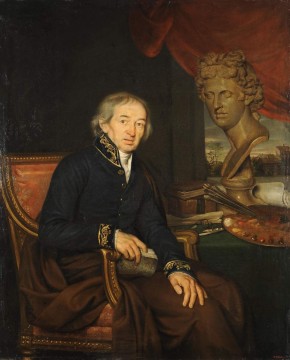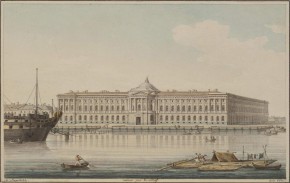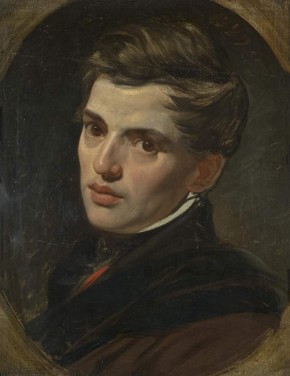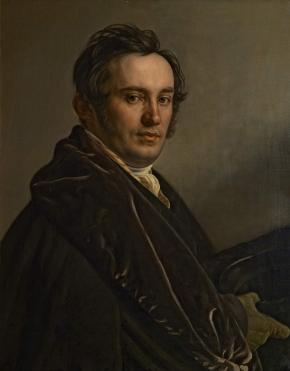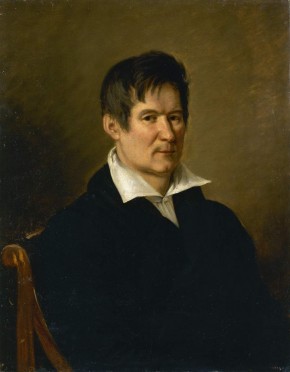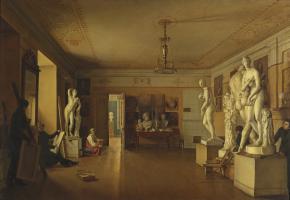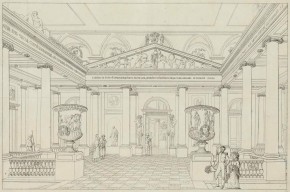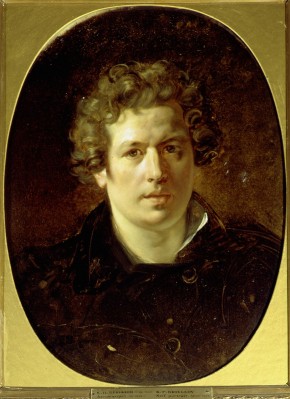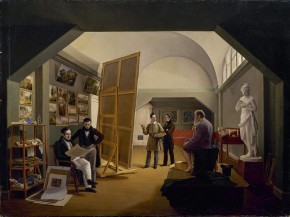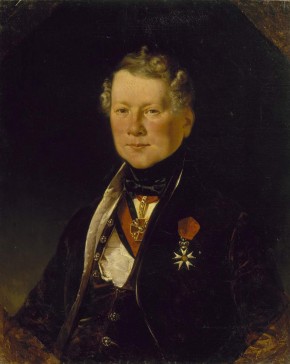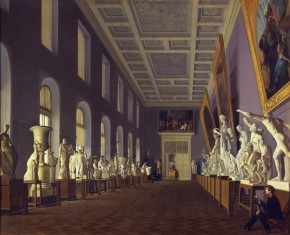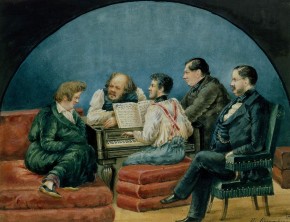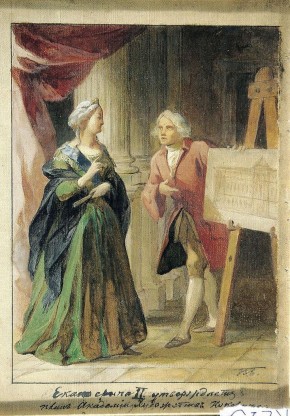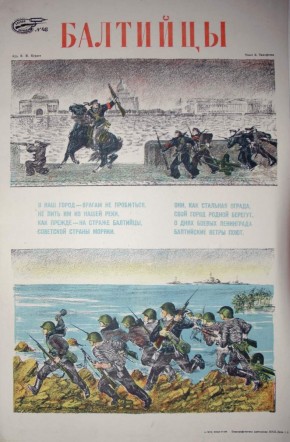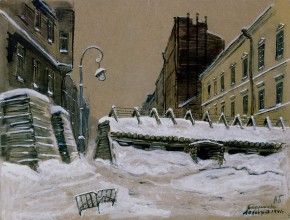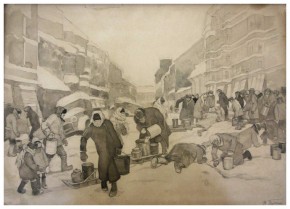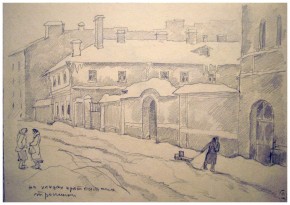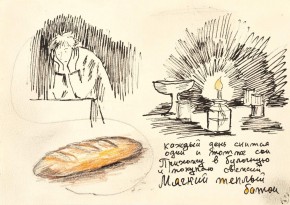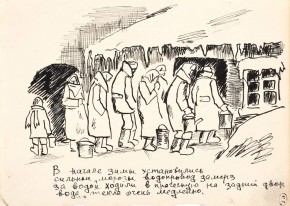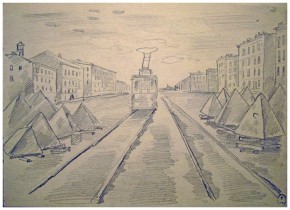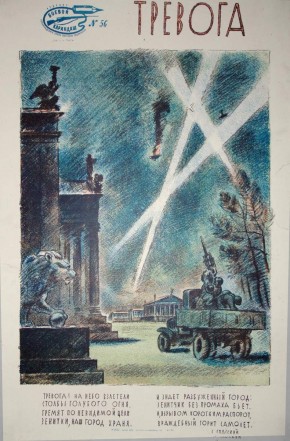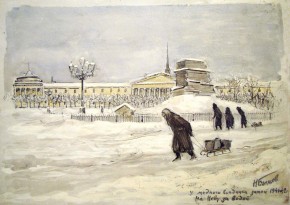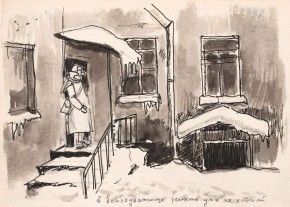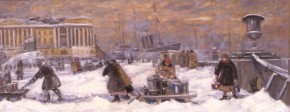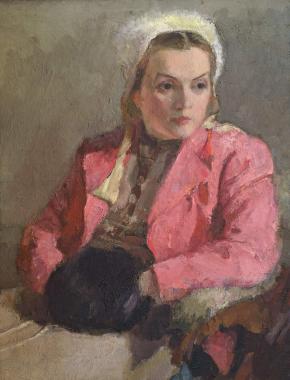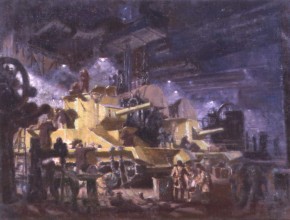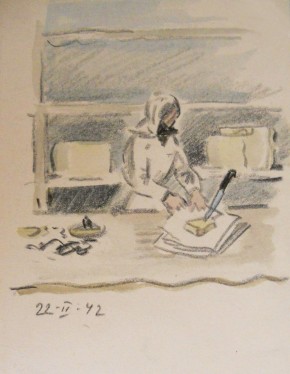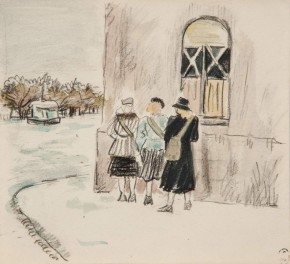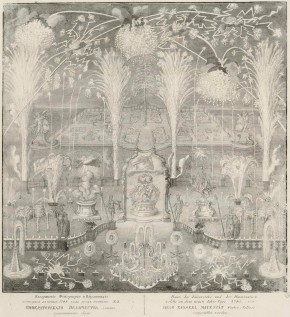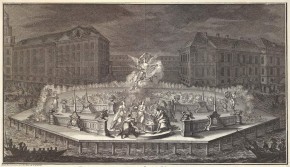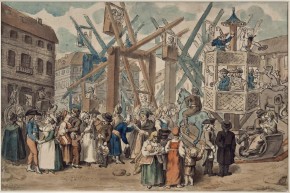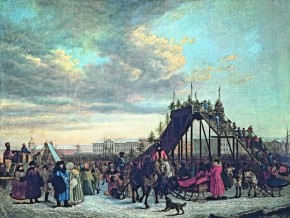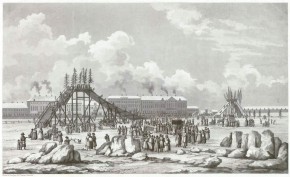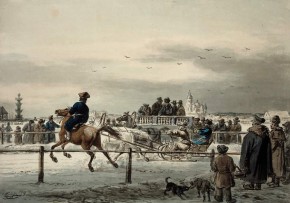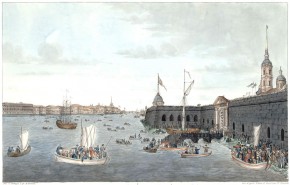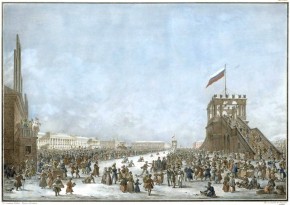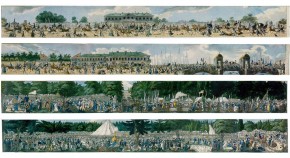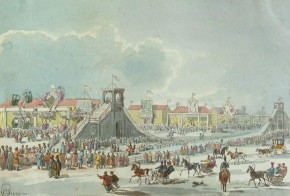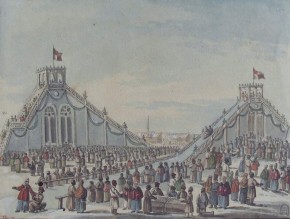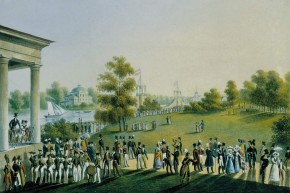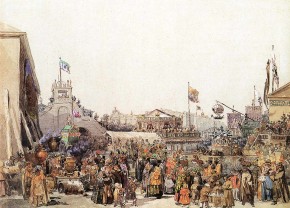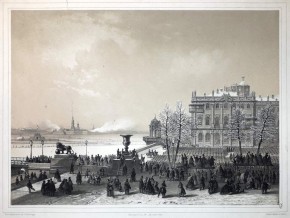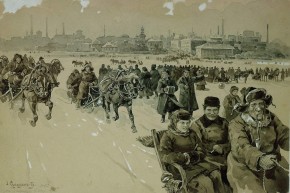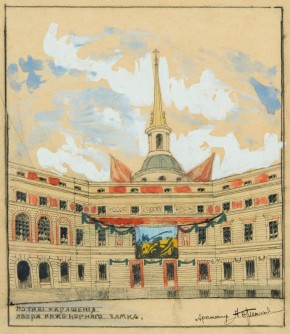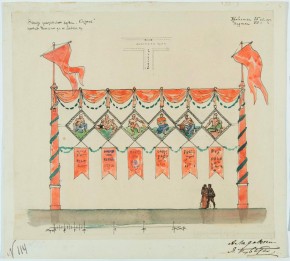Advanced search collections
Portrait of Peter I
- Paper, .
- The State Russian Museum
- Гр-28586
Медаль «Небываемое бывает» / За взятие двух шведских судов 6 мая 1703 г. в устье р. Невы
- 1703
- Silver.
- The State Russian Museum
- Мед.А-522
Медаль на сооружение крепости Кроншлот в 1704 г.
- 1704
- Silver.
- The State Russian Museum
- Мед.А-567
Флот на пути к Выборгу в 1710 году / Определенный порядок ... через каковым образом флот и транспорт Петербурга и Кронштата отправлен ...1710 г. в Выборг
- 1710
- etching, lathe.
- The State Russian Museum
- Гр.-31963
The Wedding of Peter I and Catherine
- 1712
- etching.
- The State Russian Museum
- Гр.-42519
Ввод судов в Петербург после Гангутской победы
- etching.
- The State Russian Museum
- Гр-32299
Кроншлот
- etching, lathe.
- The State Russian Museum
- Гр.-21845
Medal Commemorating the Capture of Nyenschantz in 1703
- 1703
- Silver. D-46. Total weight: 41.93 g.
- The State Russian Museum
- Мед.А-514
The desire of Peter the Great to make Russia one of the European commonwealths initiated the birth of medallic art, which before this was unknown in the Tsardom of Moscow. The famous Nuremberg medallist Philipp Heinrich Müller was ordered to create a series of 26 medals commemorating events of the Northern War. The medals were produced in 1713‒1714 using the highest quality materials and corresponding to European medallic traditions. Beginning in 1716, these commemorative medals were produced in Moscow for presentational purposes: they were presented as gifts to foreigners and senior officers of the state. The letters highlighted in the Latin legend refer to the date, on which the event took place.
Котлин остров
- 1716 - 1717
- etching, lathe.
- The State Russian Museum
- Гр.-21846
План крепости, города и местоположение Санкт-Петербурга
- 1716
- .
- The State Russian Museum
- Гр.-38438
Portrait of Peter I
- 1718
- etching, lathe.
- The State Russian Museum
- Гр.-31063
Заглавный лист книги "Устав морской" (фронтиспис)
- Paper, .
- The State Russian Museum
- Гр.-22774
Торжественный ввод в Санкт-Петербург шведских судов после победы при Гренгаме
- etching.
- The State Russian Museum
- Гр-32305
Фейверк по случаю победы при Гренгаме / Гренгамская пирамида
- 1720
- etching, lathe.
- The State Russian Museum
- Гр.-26131
Топографическое изображение новой русской столицы и порта Санкт-Петербурга
- 1721–1723
- .
- The State Russian Museum
- Гр.-38442
Проект Александро-Невской лавры
- etching.
- The State Russian Museum
- Гр-37398
View of St. Petersburg
- etching.
- The State Russian Museum
- Гр-41990
Проспект палат Великого Амирала
- 1729
- etching, lathe.
- The State Russian Museum
- Гр.-42311
Церковь святой Троицы
- 1729
- .
- The State Russian Museum
- Гр.-23735
Географическая карта Ингерманландии
- 1734
- .
- The State Russian Museum
- Гр.-38775
Шенк Петр
Kalashnikov Osip
Müller/ Miller/ Myller Philipp Heinrich
Picart, Pickaerdt Pieter
Зубов Алексей Федорович
Unknown engraver
Heu Beracken
Челнаков Никита Федорович
Эллигер Оттоман
Portrait of Peter I
- Paper, .
- The State Russian Museum
- Гр-28586
The Wedding of Peter I and Catherine
- 1712
- etching.
- The State Russian Museum
- Гр.-42519
Medal Commemorating the Capture of Nyenschantz in 1703
- 1703
- Silver. D-46. Total weight: 41.93 g.
- The State Russian Museum
- Мед.А-514
The desire of Peter the Great to make Russia one of the European commonwealths initiated the birth of medallic art, which before this was unknown in the Tsardom of Moscow. The famous Nuremberg medallist Philipp Heinrich Müller was ordered to create a series of 26 medals commemorating events of the Northern War. The medals were produced in 1713‒1714 using the highest quality materials and corresponding to European medallic traditions. Beginning in 1716, these commemorative medals were produced in Moscow for presentational purposes: they were presented as gifts to foreigners and senior officers of the state. The letters highlighted in the Latin legend refer to the date, on which the event took place.
План крепости, города и местоположение Санкт-Петербурга
- 1716
- .
- The State Russian Museum
- Гр.-38438
Portrait of Peter I
- 1718
- etching, lathe.
- The State Russian Museum
- Гр.-31063
Топографическое изображение новой русской столицы и порта Санкт-Петербурга
- 1721–1723
- .
- The State Russian Museum
- Гр.-38442
Проект Александро-Невской лавры
- etching.
- The State Russian Museum
- Гр-37398
View of St. Petersburg
- etching.
- The State Russian Museum
- Гр-41990
Церковь святой Троицы
- 1729
- .
- The State Russian Museum
- Гр.-23735
Географическая карта Ингерманландии
- 1734
- .
- The State Russian Museum
- Гр.-38775
Вид на Адмиралтейство / Проспект Адмиралтейства и около лежащих строений с частью Невской перспективной дороги в западную сторону
- 1753
- Paper, .
- The State Russian Museum
- Гр.-3062
Проспект Невской перспективной дороги от Адмиралтейских триумфальных ворот к востоку
- 1753
- .
- The State Russian Museum
- Гр.-3063
Проспект вверх по Неве от Адмиралтейства и Академии наук к востоку
- 1753
- .
- The State Russian Museum
- Гр.-3057
Проспект вниз по Неве между Зимним <...> Домом и Академией наук
- 1753
- .
- The State Russian Museum
- Гр.-3060
Проспект по реке Фонтанке от Грота и запасного дворца на полдень
- 1753
- etching, lathe.
- The State Russian Museum
- Гр.-3066
Летний дворец Елизаветы Петровны с южной стороны
- 1750–1757
- Paper, ink, nib, brush.
- The State Russian Museum
- Р-1308
Летний дворец Елизаветы Петровны со стороны Летнего сада в Петербурге
- Canvas, oil.
- The State Russian Museum
- Ж-3132
Здание Двенадцати коллегий в Петербурге
- Canvas, oil.
- The State Russian Museum
- Ж-4923
Portrait of Peter the Great
- 1770
- Canvas, oil. 268 x 159
- The State Russian Museum
- Ж-25
Peter the Great is depicted in the uniform of the Preobrazhensky Guards and an Imperial mantle. He is wearing the chain and star of the Order of St Andrew. The Russian Imperial crown stands on the table. The Emperor is pointing to an open book displaying the text of the Manifesto of 1721 with which he established the Synod, a collegiate body that would administer the Church in place of the traditional Patriarchate. The portrait was painted by Alexei Antropov, who served as a painter at the Synod from 1761.
Вид Невского проспекта от Полицейского моста с домом графа А. С. Строганова
- Canvas, oil. 72 x 117
- The State Russian Museum
- Ж-3128
Виноградов Ефим Григорьевич
Качалов Григорий Аникиевич
Махаев Михаил Иванович
Unknown painter
Antropov Alexei Petrovich
1716, St. Petersburg - 1795, St. PetersburgPainter, portraitist, icon-painter. Studied under Louis Caravaque, Andrei Matveyev and Alexander Zakharov, took lessons from Pietro de Rotari (from 1732). Joined the painting department of the Ministry of Construction (1739), foreman (1749). Helped to decorate the interiors of palaces in and around St Petersburg and Moscow. Painted the interior decor of the Si Petersburg Opera House (1750). Created murals and icons for St Andrew’s Cathedral in Kiev (1750-55). Lived in St Petersburg (from 1758). Worked for the Holy Synod and supervised the work of painters (from 1761), Taught Dmitry Levitsky and Pyotr Drozhdin.
Медаль «Небываемое бывает» / За взятие двух шведских судов 6 мая 1703 г. в устье р. Невы
- 1703
- Silver.
- The State Russian Museum
- Мед.А-522
Медаль на сооружение крепости Кроншлот в 1704 г.
- 1704
- Silver.
- The State Russian Museum
- Мед.А-567
Флот на пути к Выборгу в 1710 году / Определенный порядок ... через каковым образом флот и транспорт Петербурга и Кронштата отправлен ...1710 г. в Выборг
- 1710
- etching, lathe.
- The State Russian Museum
- Гр.-31963
Ввод судов в Петербург после Гангутской победы
- etching.
- The State Russian Museum
- Гр-32299
Кроншлот
- etching, lathe.
- The State Russian Museum
- Гр.-21845
Котлин остров
- 1716 - 1717
- etching, lathe.
- The State Russian Museum
- Гр.-21846
Заглавный лист книги "Устав морской" (фронтиспис)
- Paper, .
- The State Russian Museum
- Гр.-22774
Торжественный ввод в Санкт-Петербург шведских судов после победы при Гренгаме
- etching.
- The State Russian Museum
- Гр-32305
Фейверк по случаю победы при Гренгаме / Гренгамская пирамида
- 1720
- etching, lathe.
- The State Russian Museum
- Гр.-26131
View of St. Petersburg
- etching.
- The State Russian Museum
- Гр-41990
Проспект палат Великого Амирала
- 1729
- etching, lathe.
- The State Russian Museum
- Гр.-42311
Проспект Биржи и Гостиного двора вверх по малой Неве реке
- 1750–1751
- etching, lathe.
- The State Russian Museum
- Гр.-3029
Проспект Летнего Ее Императорского Величества дому с Северную сторону
- 1750–1751
- etching, lathe.
- The State Russian Museum
- Гр.-3031
Проспект по реке Фонтанке от Грота и Запасного дворца на полдень
- 1750–1751
- etching, lathe.
- The State Russian Museum
- Гр.-3030
Проспект старого Зимнего дворца с каналом, соединяющим Мойку с Невою
- 1750–1751
- etching, lathe.
- The State Russian Museum
- Гр.-3028
Вид Биржи и Гостиного двора вверх по Малой Неве
- Paper, ink, brush, nib.
- The State Russian Museum
- Р-60085
Вид на старый Зимний дворец и канал, соединяющий Мойку с Невою
- Paper, ink, brush, nib.
- The State Russian Museum
- Р-60083
Проспект вверх по Неве реке к востоку между Галерной верфью и 13 линией Васильевского острова
- 1751–1753
- etching, lathe, .
- The State Russian Museum
- Гр.-3023
Проспект вверх по Неве реке от Адмиралтейства и Академии Наук к востоку
- 1751–1753
- etching, lathe, .
- The State Russian Museum
- Гр.-3021
Проспект вниз по Неве реке между Зимним Ее Императорского Величества домом и Академией Наук
- 1751–1753
- etching, lathe, .
- The State Russian Museum
- Гр.-3024
Греков Алексей Ангилеевич (Ангильевич)
Еляков Иван Петрович
Васильев Яков Васильевич
Проспект палат Великого Амирала
- 1729
- etching, lathe.
- The State Russian Museum
- Гр.-42311
Проспект Биржи и Гостиного двора вверх по малой Неве реке
- 1750–1751
- etching, lathe.
- The State Russian Museum
- Гр.-3029
Проспект старого Зимнего дворца с каналом, соединяющим Мойку с Невою
- 1750–1751
- etching, lathe.
- The State Russian Museum
- Гр.-3028
Вид Биржи и Гостиного двора вверх по Малой Неве
- Paper, ink, brush, nib.
- The State Russian Museum
- Р-60085
Вид на старый Зимний дворец и канал, соединяющий Мойку с Невою
- Paper, ink, brush, nib.
- The State Russian Museum
- Р-60083
Проспект вверх по Неве реке к востоку между Галерной верфью и 13 линией Васильевского острова
- 1751–1753
- etching, lathe, .
- The State Russian Museum
- Гр.-3023
Проспект вверх по Неве реке от Адмиралтейства и Академии Наук к востоку
- 1751–1753
- etching, lathe, .
- The State Russian Museum
- Гр.-3021
Проспект вниз по Неве реке между Зимним Ее Императорского Величества домом и Академией Наук
- 1751–1753
- etching, lathe, .
- The State Russian Museum
- Гр.-3024
Проспект вниз по Неве реке от Невского моста между Исаакиевскою церковью и корпусом кадетским
- 1751–1753
- etching, lathe, .
- The State Russian Museum
- Гр.-3022
Проспект вверх по Неве от Адмиралтейства и Академии наук к востоку
- 1753
- .
- The State Russian Museum
- Гр.-3057
Проспект вверх по Неве-реке между Галерною верфью и 13 линией Васильевского острова
- Canvas, oil. 116 x 201
- The State Russian Museum
- Ж-3137
Проспект вниз по Неве-реке от Невского моста между Исаакиевской церковью и корпусом кадетским
- Canvas, oil. 116 x 202
- The State Russian Museum
- Ж-3133
Вид вниз по Неве от Петропавловской крепости
- 1759–1760
- paper mounted on canvas, ink, brush, nib.
- The State Russian Museum
- Р-28995
Новый Ее Императорского Величества Зимний дом с реки Невы
- 1761
- etching.
- The State Russian Museum
- Гр.-43839
Санкт-Петербургская на Неве реке крепость
- 1761
- etching.
- The State Russian Museum
- Гр.-43838
Зимний дворец вниз по Неве
- 1762
- paper mounted on canvas, ink, brush, nib.
- The State Russian Museum
- Р-1310
Проспект вверх по Неве реке от Адмиралтейства и Академии Наук к востоку
- Canvas, oil. 116 x 201
- The State Russian Museum
- Ж-3135
Проспект вниз по Неве реке между Зимним домом и Академиею Наук
- Canvas, oil. 116 x 201
- The State Russian Museum
- Ж-3136
Строения на набережных Невы
- 1779
- .
- The State Russian Museum
- Гр.-22989
Вид на Петропавловскую крепость
- Canvas, oil.
- The State Russian Museum
- Ж-3154
Внуков Филипп Терентьевич
Рудаков Алексей Гаврилович
Mayr (de Mayr, von Mayr, Mayer, Meyer) Johann Georg
1760, Nuremberg (Germany) - 1816, St PetersburgPainter, draughtsman, landscapist, portraitist, il¬lustrator, engraver. Elder brother of the draughts-man and engraver Johann Christoph Mayr. Studied in Nuremberg. Invited to St Petersburg (1778). Worked atthe Imperial Academyof Sciences, draw¬ing inventions and texts , turning sketches into finished drawings for copper engraving, correct¬ing new engravings and teaching drawing, engrav¬ing and watercolour painting. Awarded more du¬ties and students following the appointment of Princess Ekaterina Dashkova as director of the Im¬perial Academy of Sciences (1783). Painted en¬gravings made by other artists (from 1788).
Проспект палат Великого Амирала
- 1729
- etching, lathe.
- The State Russian Museum
- Гр.-42311
Проспект новопостроенных палат против Аничковских ворот от восточной стороны с частью Санкт-Петербурга и Невской перспективой дороги от реки Фонтанки
- 1749–1750
- etching, lathe.
- The State Russian Museum
- Гр.-3025
Проспект Биржи и Гостиного двора вверх по малой Неве реке
- 1750–1751
- etching, lathe.
- The State Russian Museum
- Гр.-3029
Проспект Летнего Ее Императорского Величества дому с Северную сторону
- 1750–1751
- etching, lathe.
- The State Russian Museum
- Гр.-3031
Проспект Невской перспективой дороги от Адмиралтейских ворот к востоку
- 1750–1751
- etching, lathe, .
- The State Russian Museum
- Гр.-3026
Проспект по реке Фонтанке от Грота и Запасного дворца на полдень
- 1750–1751
- etching, lathe.
- The State Russian Museum
- Гр.-3030
Проспект старого Зимнего дворца с каналом, соединяющим Мойку с Невою
- 1750–1751
- etching, lathe.
- The State Russian Museum
- Гр.-3028
Вид на старый Зимний дворец и канал, соединяющий Мойку с Невою
- Paper, ink, brush, nib.
- The State Russian Museum
- Р-60083
Проспект вверх по Неве реке к востоку между Галерной верфью и 13 линией Васильевского острова
- 1751–1753
- etching, lathe, .
- The State Russian Museum
- Гр.-3023
Проспект вверх по Неве реке от Адмиралтейства и Академии Наук к востоку
- 1751–1753
- etching, lathe, .
- The State Russian Museum
- Гр.-3021
Проспект вниз по Неве реке между Зимним Ее Императорского Величества домом и Академией Наук
- 1751–1753
- etching, lathe, .
- The State Russian Museum
- Гр.-3024
Проспект вниз по Неве реке от Невского моста между Исаакиевскою церковью и корпусом кадетским
- 1751–1753
- etching, lathe, .
- The State Russian Museum
- Гр.-3022
Проспект вверх по Неве от Адмиралтейства и Академии наук к востоку
- 1753
- .
- The State Russian Museum
- Гр.-3057
Амфитеатр для увеселения каждого на Каменном острове
- 1754
- etching, lathe.
- The State Russian Museum
- Гр.-35023
Вид Невского проспекта от Аничкова моста с домом И. И. Шувалова
- Canvas, oil.
- The State Russian Museum
- Ж-3138
Проспект вверх по Неве-реке между Галерною верфью и 13 линией Васильевского острова
- Canvas, oil. 116 x 201
- The State Russian Museum
- Ж-3137
Проспект вниз по Неве-реке от Невского моста между Исаакиевской церковью и корпусом кадетским
- Canvas, oil. 116 x 202
- The State Russian Museum
- Ж-3133
Проспект Летнего Ее Императорского Величества дому с северную сторону
- etching, lathe, .
- The State Russian Museum
- Гр.-44152
Вид вверх по реке Мойке от Крюкова канала и дворца графа П. И. Шувалова
- 1759
- Paper, ink, brush, nib.
- The State Russian Museum
- P-13006
Новый Ее Императорского Величества Зимний дом с реки Невы
- 1761
- etching.
- The State Russian Museum
- Гр.-43839
Соколов Иван Алексеевич
Церковь святой Троицы
- 1729
- .
- The State Russian Museum
- Гр.-23735
Проспект новопостроенных палат против Аничковских ворот от восточной стороны с частью Санкт-Петербурга и Невской перспективой дороги от реки Фонтанки
- 1749–1750
- etching, lathe.
- The State Russian Museum
- Гр.-3025
Проспект Летнего Ее Императорского Величества дому с Северную сторону
- 1750–1751
- etching, lathe.
- The State Russian Museum
- Гр.-3031
Проспект Невской перспективой дороги от Адмиралтейских ворот к востоку
- 1750–1751
- etching, lathe, .
- The State Russian Museum
- Гр.-3026
Проспект по реке Фонтанке от Грота и Запасного дворца на полдень
- 1750–1751
- etching, lathe.
- The State Russian Museum
- Гр.-3030
Проспект старого Зимнего дворца с каналом, соединяющим Мойку с Невою
- 1750–1751
- etching, lathe.
- The State Russian Museum
- Гр.-3028
Зимний дворец императрицы Анны Иоанновны со стороны Луговой улицы
- 1751
- Paper, ink, nib, brush.
- The State Russian Museum
- Р-1309
Вид Невской перспективой дороги от Адмиралтейских триумфальных ворот к востоку
- Paper, ink, brush, nib.
- The State Russian Museum
- Р-60086
Вид на старый Зимний дворец и канал, соединяющий Мойку с Невою
- Paper, ink, brush, nib.
- The State Russian Museum
- Р-60083
Проспект вниз по Неве реке между Зимним Ее Императорского Величества домом и Академией Наук
- 1751–1753
- etching, lathe, .
- The State Russian Museum
- Гр.-3024
Вид Невского проспекта от Аничкова моста с домом И. И. Шувалова
- Canvas, oil.
- The State Russian Museum
- Ж-3138
Охотничий павильон в Зверинце Царского Села
- 1755
- paper mounted on canvas, ink, brush, nib.
- The State Russian Museum
- Р-1312
Петергоф. Большой дворец со стороны залива
- 1756
- paper mounted on canvas, ink, brush, nib, , graphite pencil.
- The State Russian Museum
- Р-28996
Проспект Летнего Ее Императорского Величества дому с северную сторону
- etching, lathe, .
- The State Russian Museum
- Гр.-44152
Большой дворец в Ораниенбауме
- paper mounted on canvas, ink, brush, nib.
- The State Russian Museum
- Р-1311
Эрмитаж в саду Ее Императорского Величества дворца в Сарском Селе
- 1757–1759
- etching, lathe.
- The State Russian Museum
- Гр.-31861
Вид вверх по реке Мойке от Крюкова канала и дворца графа П. И. Шувалова
- 1759
- Paper, ink, brush, nib.
- The State Russian Museum
- P-13006
Дворец Ее Императорского Величества в Сарском Селе
- 1757–1761
- etching, lathe, , .
- The State Russian Museum
- Гр.-31868; Гр.-31869
Петергофский Ее Императорского Величества дворец на берегу Финляндского залива
- 1760–1761
- etching, lathe.
- The State Russian Museum
- Гр.-3129
Новый Ее Императорского Величества Зимний дом с реки Невы
- 1761
- etching.
- The State Russian Museum
- Гр.-43839
Внуков Еким (Аким, Яким) Терентьевич
Артемьев Прокофий (Прокопий) Артемьевич
Портрет императрицы Елизаветы Петровны
- 1746
- etching, lathe, .
- The State Russian Museum
- Гр.-30752
Проспект Летнего Ее Императорского Величества дому с Северную сторону
- 1750–1751
- etching, lathe.
- The State Russian Museum
- Гр.-3031
Прием Зюнгарского владельца
- 1796
- etching, lathe.
- The State Russian Museum
- Гр.-36945
Portrait of Emperor Paul I
- Canvas, oil. 73 x 57
- The State Russian Museum
- Ж-3170
Emperor Paul I (1754–1801) was the only son of Emperor Peter III and Empress Catherine the Great. In 1762 he was named heir to the throne and given the title of Tsesarevich. He received an excellent education and believed in the romantic ideals of enlightened absolutism, but was critical of the policies of Catherine the Great. He spent decades waiting for the power that his mother had usurped. He became emperor in 1796. His efforts were intended to be to the state’s benefit, but he often acted against common sense. At his coronation in Moscow in 1797 he promulgated the Establishment of the Imperial Family which laid down that accession to the throne should be by primogeniture in the male line. He reformed local government. He restricted the rights of the nobility and allowed corporal punishment to be used on them. Military reforms affected not only uniforms and equipment, but also training and the tactics of officers and soldiers, with an emphasis on the Prussian military school. In an effort to protect Russia from revolutionary ideas, he banned the import of books from France and tightened censorship. In 1798, he took on the title of Grand Master of the Knights of St John of Jerusalem, of Rhodes and of Malta (Hospitaller), and took it under his patronage. He was killed by conspirators in St Michael’s Castle during the night of 11–12 March 1801, but according to the official version he died of an apoplectic fit (a stroke).
Портрет Александра I (1777-1825)
- 1800s
- Canvas, oil. 54 х 36
- The State Russian Museum
- Ж-4652
Вид печальной процессии 6 марта 1826 года в Санкт-Петербурге
- 1826
- Lithography.
- The State Russian Museum
- Гр.-28908
Costume Ball in the Winter Palace under Nicholas I
- Early 1830s
- Canvas, oil. 56.5 x 78.2
- The State Russian Museum
- Ж-3804
One of the most important aspects of the life of the Russian nobility was balls. The main element of the ball was dancing. In the eighteenth century, balls traditionally began with a minuet. At the start of the nineteenth century, however, the opening dance was the polonaise, followed by the waltz. The waltz was a fashionable dance for young people, only permitted at balls as a tribute to the changing times. The centre and culmination of the ball was the mazurka. One of the concluding dances was the cotillion. Play and Passion in Russian Fine Art. St-Petersburg. 1999. P. 128.
Balls and festivities in the Winter Palace were major events in St Petersburg high society. In the centre of the hall there is a fancy - dress procession with many participants dressed in oriental costumes. This period, the age of Romanticism, was characterised by an interest in oriental culture. At one such festivity in 1821, the future Emperor Nicholas I was dressed as a Bokhara prince, and his wife, Charlotte of Prussia, as an Indian princess. Play and Passion in Russian Fine Art. St-Petersburg. 1999. P. 129.
Бал у княгини М. Ф. Барятинской
- Paper, watercolours. 16 х 18,4
- The State Russian Museum
- Р-633
Yelagin Island Guardhouse with a Sentry of the Horse Guards Regiment
- 1840
- Canvas, oil. 68,5 x 97
- The State Russian Museum
- Ж-4625
Торжественный въезд принцессы Александры Саксен-Альтенбургской в Санкт-Петербург
- 1847
- Paper, watercolours, white pigment, bronze. 45,4 х 56,3
- The State Russian Museum
- Р-3012
Известие из Крыма 1854 года. Кабинет императора Николая I в Зимнем дворце в Петербурге
- 1850s
- Paper, .
- The State Russian Museum
- Гр-31746
Nicholas I in a Sledge
- Canvas, oil.
- The State Russian Museum
- Ж-2696
Nikolai Sverchkov, the son of a court coachman and groom, dedicated his entire artistic career to equine painting and the Imperial Court, which frequently commissioned work from him. Regardless of the subject, his canvases almost always featured horses. The portraits Sverchkov painted were no exception. The artist’s models, as a rule, either were riding in horse-drawn carriages or were sitting on horses. This half-portrait/half-genre painting by Sverchkov is devoid of the usual pomp of works that depict the emperor – this case, Nicholas I – and shows him outside of an official situation, causing us to see him less as an autocrat, and more as a private person.
Emperor Nicholas I (1796–1855) was the third son of Emperor Paul I and Empress Marie Feodorovna. He ascended to the throne in 1825. The reign of Nicholas I is characterised by the centralisation of government and regulation in all areas of activity. In 1826, he created the Third Section of His Imperial Majesty’s Own Chancellery, which was tasked with monitoring the political reliability of subjects, and in 1827, he published a new censorship decree, which was called “cast iron” by his contemporaries. The foundation of his domestic policies was the principle of “autocracy, orthodoxy and nationality”. The sanctity of the autocracy also formed the basis for his foreign policy. In 1833, an agreement was reached between Russia, Austria and Prussia on reciprocal support in the case of a political crisis. This agreement is what led Nicholas I to send troops to help suppress the Hungarian Uprising (1848–1849). His assumption of the role of protector of Christian peoples under Muslim rule determined the direction of his Eastern foreign policy. The Russo-Turkish War (1828–1829) contributed to Greece gaining its independence (1830). The last years of Nicholas I’s reign were overshadowed by setbacks in the Crimean War (1853–1856). The character and activities of the Emperor caused contradictory assessments among his contemporaries, from enthusiastic veneration (“The Knight of Autocracy”) to definitive opposition (“The Gendarme of Europe”).
Известие из Крыма
- 1854
- Lithography.
- The State Russian Museum
- Гр.-35659
Бал в Зимнем дворце
- 1858
- Paper, watercolours, . 23 х 23
- The State Russian Museum
- Рб-5557
Детская мельница в Александрии
- 1858
- Paper, watercolours, . 28,1 × 20,7
- The State Russian Museum
- Рб-5572
Детский домик Цесаревны
- 1858
- Paper, watercolours. 28.3 x 20,2
- The State Russian Museum
- Рб-5571
Николай I на работах в Петергофе
- 1858
- Paper, watercolours. 28,7 х 19,5
- The State Russian Museum
- Рб-5570
Серебряный темляк за науки
- 1858
- Paper, watercolours, . 23 х 23
- The State Russian Museum
- Рб-5556
The Ice House
- 1878
- Canvas, oil. 133,5 х 216
- The State Russian Museum
- Ж–2945
Fancy dress balls were very popular among the Russian nobility of the eighteenth century. Although by that time their external appearance was already entirely European, they were not always marked by the same European refinement. The wedding of the court jester of Prince Golitsyn and the jester of Buzheninova, held by Empress Anna Ioannovna on 6 February 1740 in an ice house on the Neva, was one of the most original, but also absurd and crude, ventures of her ten - year reign.
The banquet is over and the newly - weds have set off, accompanied by their numerous and brightly coloured procession, in their previous order, to the ice house. Here, to the sound of trumpets, kettle drums and oboes and choir of goats, bulls, dogs and donkeys, they have been let out of their iron cage and led with fitting honour to the bedroom, where they have been locked in. The convoy has dispersed. Sentries have been placed outside the house so that the loving couple make their cannot escape. Such is the altar to Hymen... Everything you sit on or touch is ice - the walls, the wedding bed, the gob lets. Everything blazes with the cold; closer, tighter, finally smothering and freezing them.
[I. Lazhechnikov, The Ice House] Play and Passion in Russian Fine Art. St-Petersburg. 1999. P. 152.
Valery Jacoby painted a whole series of pictures with subjects taken from the time of Empress Anna Ioannovna. The painting The Ice House occupies a special place among them, and depicts one of the strangest episodes in the life of the imperial court.
The Ice House was built on the square between the Admiralty and the Winter Palace during Shrovetide in 1739. The outside walls and the inner décor were entirely made of ice. The Ice House was the site of the marriage of the Empress’s jester Prince Mikhail Golitsyn to her female jester Eudoxia Buzheninova (probably a deliberate nickname, as buzhenina was the Empress’s favourite dish, cold baked pork). Besides the Empress and her courtiers, the wedding festivities were attended by a total of 150 representatives of the various nationalities inhabiting the Russian Empire, including Ukrainians, White Russians, Finns, Tatars, Komi-Zyrians and Kamchadals (Itelmens). The guests donned their national attire and engaged in traditional folk dancing. When the feast was over, the newly-weds were taken back to the Ice House and locked in for the night.
The story of the jester’s wedding led Ivan Lazhechnikov to write a critical novel entitled The Ice House. Although Valery Jacoby appears to have read the book, his painting concentrates more on the external facets of the episode. The artist depicts the bright and motley crowd dancing before the Empress and her courtiers.
Николай I с цесаревичем Александром Николаевичем в мастерской художника в 1854 году
- Canvas, oil.
- The State Russian Museum
- Ж-2923
Казачинский Андрей Иванович
Borovikovsky Vladimir Lukich
1757, Mirgorod - 1825, St PetersburgPainter, draughtsman, miniaturist, icon painter, portraitist. Born into a family of low rank Cossacks. Studied painting under his father, the icon painter Luke Borovik, in Mirgorod. Listed "above the specified number" in the Mirgorod regiment where his father and relatives served (1774). Awarded the rank of "comrade of the colours" (1783), resigned with the rank of lieutenant. Moved to St Petersburg (1788) and studied under Dmitry Levitsky and Johann Baptiste I Lampi. Nominated to the Imperial Academy of Arts (1794), academician of portrait painting (1795). Councillor of the Imperial Academy of Arts (1802). Contributed to the iconostasis of the Kazan Cathedralin St Petersburg (1804). Mason and member of Ekaterina Tatarinova\'\'s mystical sect.
Кюгельген Герхард-Франц фон
Beggrow Carl Рetrovich (Carl Joachim)
1799, Riga - 1875, St PetersburgLithographer, watercolourist, painter. Studied under Maxim Vorobyov at the Imperial Academy of Arts (1818-21). Worked as a lithographer at the Central Board of Communications (from 1825). Nominated to the Imperial Academy of Arts (1831), academician of perspective painting (1832). Worked on commissions for the Society for the Encouragement of Artists (1820s-early 1830s), contributed to the series Views of St Petersburg and Envimns.
WILLEWALDE, Gottfried (Bogdan)
1818 (1819?), ? - 1903, DresdenPainter, battle painter, genre artist, portraitist, landscapist. Studied under Karl Brullov and Alexander Sauerweid at the Imperial Academy of Arts (1843-1844). Taught at the School of Drawing, Society for the Encouragement of Artists, St Petersburg (1840-1842). Contributed to exhibitions (from 1842). Foreign fellow of the Imperial Academy of Arts (1843-1844). Summoned to St Petersburg by order of Nicholas I to complete works commissioned from deceased Alexander Sauerweid (1864). Appointed teacher of drawing for Grand Dukes Nicholas Nikolayevich and Michael Nikolayevich. Taught at the school of the Society of St Petersburg Artists (1840-1842). Taught at the Imperial Academy of Arts (1848-1894). Academician of painting (from 1845), professor of battle-painting (from 1848), member of the Academy Council (from 1859), first-class professor (с 1872). Professor emeritus (1888).
Gagarin Grigory Grigorievich
1810 – 1893LADURNER, Adolphe Ignatyevich
1799/1800?, Paris? - 1855, St PetersburgFrench battle painter, lithographer, portraitist. Son of the German pianist and composer Ignaz Ladurner (1766-1839). Studied art under Oras Vernet in Paris. Exhibited at the Salon in 1824 (The Battle of Matarу) and in 1827 (Headquarters of King’s Lancers). Worked in Warsaw and Dresden; in Russia from 1831. Author of numerous battle scenes, parades and regimental ceremonies. Was under the protection of Nicholas I. Academician of the Imperial Academy of Arts (1837), third-class professor (from 1840). Awarded the Order of St Stanislaus 3rd Class for drawings of uniforms of the Russian Army (1844). Served as an artist at the Editorial Office of the Russian Military Chronicles. Commissioned by Emperor Nicholas I to create a series of paintings (more than 40) of a single format (68 х 97) depicting guard regiments for the Russian Guards collection, which then were lithographed and printed on porcelain vases and plates. Active participant in annual academic exhibitions.
Садовников Василий Семенович
Козлов Александр Алексеевич
Sverchkov Nikolai Yegorovich
1817 St. Petersburg - 1898, Tsarskoye SeloPainter, draughtsman, lithographer, genre artist, portraitist, animal artist. Born into a family of a cabman. Did not receive professional artistic education. Worked for the Ministry of the Interior (until 1842). Awarded the title of free portraitist at the Imperial Academy of Arts for Rider, Self-Portrait, etc. (1839). undertook painting commissions from Khrenov and Çesme stud farms (from 1840s). Academician for Landowner’s Troika (1852), professor (1855). Awarded the Légion d’honneur at the World Exhibition in Paris (1863) for Return from the Bear Hunt, Fair in Voronezh, Postal Station.
Ziche, Michaly
Jacobi Valery Ivanovich
1834, d. Kondrakova Laishevsky County Kazan province - 1902, NicePainter, genre artist, history painter. Studied at the Kazan Grammar School and Kazan University. Left the University to join the Simbirsk Home Guard during the Crimean War (1854-1855). Studied at the Imperial Academy of Arts (1856-1861). Contributed to exhibitions (from 1858). First-class artist (1861), fellow of the Imperial Academy of Arts in Germany, Switzerland, France and Italy (1862-1868). Academician (1868), professor (1871). Founding member of the Society of Travelling Art Exhibitions (1870). Taught at the Imperial Academy of Arts (1878-1889), headed the history painting class (from 1883).
Развод караула на Дворцовой площади
- Canvas, oil.
- The State Russian Museum
- Ж-3149
Молебствие и парад по случаю окончания военных действий в Царстве Польском 6 октября 1831 года на Царицыном лугу в Санкт-Петербурге
- 1831
- Canvas, oil. 48 х 71
- The State Russian Museum
- Ж-3604
Parade Celebrating the End of Millitary Action in the Kingdom of Poland on Tsaritsa Meadow in St Petersburg on 6 October 1831
- 1837
- Canvas, oil. 212 х 345
- The State Russian Museum
- Ж-6350
The parade took place one month after the capture of Warsaw. The painting depicts the panorama of Tsaritsa Meadow (today the Fields of Mars): the Summer Garden, the Engineers Castle, the Mikhailovsky Garden and the Rossi Pavilion, the Michailovsky Palace and the Barracks of the Pavlovsky Regiment. Alongside the barracks, two regiments are formed: a regiment of cavalry along the Palace and a regiment of artillery along the Summer Garden. Nikolai I, followed by his suite, rides to the Empress carriage from the place of moleben. Among the crowd of spectators, one can find Alexander Pushkin, Vasily Zhukovsky, Ivan Krylov, Karl Brullov and Alexei Olenin alongside with other musicians, diplomats, scientists and merchants. The artist supplemented the painting by an outline drawing of 223 figures and the list of depicted characters.
Парад на Дворцовой площади
- Canvas, oil.
- The State Russian Museum
- Ж-6344
Ceremonial Consecration of the Alexander Column on Palace Square in St Petersburg on 30 August 1834
- 1840
- Canvas, oil. 301 х 485
- The State Russian Museum
- Ж-5765
Бивуак лейб-гвардии Павловского полка — отдых на походе
- 1842–1843
- paper mounted on cardboard, watercolours, varnish. 30 х 34.3
- The State Russian Museum
- Р-7746
Парад на Дворцовой площади
- 1845
- Paper, watercolours, graphite pencil. 32 x 43,6
- The State Russian Museum
- Р-6666
Chernetsov Grigory Grigoryevich
1802 Luh village of Kostroma - 1865 St. PetersburgOutstanding Russian artist, master of landscapes. Auditor at the Imperial Academy of Arts under Stepan Galaktionov (from 1821) and later in Maxim Vorobyov’s “views and landscapes class”, where Aivazovsky would later study.
Fedotov Pavel Andreyevich
1815, Moscow - 1852, St PetersburgPainter, draughtsman, poet, genre artist, portraitist, battle painter. Born in the family of a minor civil servant. Studied at the First Moscow Military Academy (1826-33) and served as an officer in the Finland Life Guards Regiment in St Petersburg (1826-33). Attended drawing classes at the Imperial Academy of Arts (1834-44) and studied battle painting under Alexander Sauerweid. Resigned from the army in order to devote himself to painting (1840). Enrolled at the Imperial Academy of Arts (1844). Took up oil painting (1846). Academician for The Major Makes a Proposal (1848).
Проспект новопостроенных палат против Аничковских ворот от восточной стороны с частью Санкт-Петербурга и Невской перспективой дороги от реки Фонтанки
- 1749–1750
- etching, lathe.
- The State Russian Museum
- Гр.-3025
Проспект Адмиралтейства и около лежащих строений с частью Невской перспективой дороги с западную сторону
- 1750–1751
- etching, lathe, .
- The State Russian Museum
- Гр.-3027
Проспект Биржи и Гостиного двора вверх по малой Неве реке
- 1750–1751
- etching, lathe.
- The State Russian Museum
- Гр.-3029
Проспект Государственных Коллегий с частью Гостиного двора с восточную сторону
- 1750
- etching, lathe.
- The State Russian Museum
- Гр.-3032
Проспект Летнего Ее Императорского Величества дому с Северную сторону
- 1750–1751
- etching, lathe.
- The State Russian Museum
- Гр.-3031
Проспект Невской перспективой дороги от Адмиралтейских ворот к востоку
- 1750–1751
- etching, lathe, .
- The State Russian Museum
- Гр.-3026
Проспект по реке Фонтанке от Грота и Запасного дворца на полдень
- 1750–1751
- etching, lathe.
- The State Russian Museum
- Гр.-3030
Проспект старого Зимнего дворца с каналом, соединяющим Мойку с Невою
- 1750–1751
- etching, lathe.
- The State Russian Museum
- Гр.-3028
Зимний дворец императрицы Анны Иоанновны со стороны Луговой улицы
- 1751
- Paper, ink, nib, brush.
- The State Russian Museum
- Р-1309
Миллионная улица от Главной аптеки к Зимнему дворцу
- 1751
- Paper, ink, brush, nib.
- The State Russian Museum
- Р-13007
Вид Государственных коллегий и Биржи (Гостиного двора)
- Paper, ink, brush, nib.
- The State Russian Museum
- Р-60084
Вид Невской перспективой дороги от Адмиралтейских триумфальных ворот к востоку
- Paper, ink, brush, nib.
- The State Russian Museum
- Р-60086
Проспект вверх по Неве реке к востоку между Галерной верфью и 13 линией Васильевского острова
- 1751–1753
- etching, lathe, .
- The State Russian Museum
- Гр.-3023
Проспект вверх по Неве реке от Адмиралтейства и Академии Наук к востоку
- 1751–1753
- etching, lathe, .
- The State Russian Museum
- Гр.-3021
Проспект вниз по Неве реке между Зимним Ее Императорского Величества домом и Академией Наук
- 1751–1753
- etching, lathe, .
- The State Russian Museum
- Гр.-3024
Проспект вниз по Неве реке от Невского моста между Исаакиевскою церковью и корпусом кадетским
- 1751–1753
- etching, lathe, .
- The State Russian Museum
- Гр.-3022
Проспект вверх по Неве от Адмиралтейства и Академии наук к востоку
- 1753
- .
- The State Russian Museum
- Гр.-3057
Вид Невского проспекта от Аничкова моста с домом И. И. Шувалова
- Canvas, oil.
- The State Russian Museum
- Ж-3138
Проспект вверх по Неве-реке между Галерною верфью и 13 линией Васильевского острова
- Canvas, oil. 116 x 201
- The State Russian Museum
- Ж-3137
Проспект вниз по Неве-реке от Невского моста между Исаакиевской церковью и корпусом кадетским
- Canvas, oil. 116 x 202
- The State Russian Museum
- Ж-3133
Вид Государственных коллегий и Биржи (Гостиного двора)
- Paper, ink, brush, nib.
- The State Russian Museum
- Р-60084
Рыбная слобода (Рыбацкое)
- Paper, watercolours. 15,7 х 27,5
- The State Russian Museum
- Р-2350
Вид нового Арсенала
- 1820s
- .
- The State Russian Museum
- Гр.Дуб.-4592
Family Portrait
- 1830
- Canvas, oil. 89 x 117
- The State Russian Museum
- Ж-5125
В комнате (семья художника)
- 1834
- Paper, watercolours. 17,5 х 27,9
- The State Russian Museum
- Р-6945
Neva Embankment at the Imperial Academy of Arts View of the Landing Wharf with Egyptian Sphinxes by Day
- 1835
- Canvas, oil. 75 x 111
- The State Russian Museum
- Ж-5122
Much of Maxim Vorobyov’s oeuvre addresses the solemnity and majesty of St Petersburg. This particular work depicts the descent to the River Neva next to the Imperial Academy of Arts — Konstantin Ton’s New Academy Landing Wharf (1832–34). The mooring point is adorned with two sculptures of Egyptian sphinxes allegedly portraying the head of Pharaoh Amenhotep III (13th century BC). Russian Museum: From Icons to the Modern Times. Palace Editions, St Petersburg, 2015. P. 116.
Зарисовки военных и бытовых групп
- 1830s
- Paper, watercolours, ink, nib, graphite pencil.
- The State Russian Museum
- Р-36406
На барке. Обед грузчиков
- 1830s
- Paper, watercolours. 15,6 х 19,9
- The State Russian Museum
- Р-2971
Торговцы рыбой и яйцами на набережной в Петербурге
- 1830s
- Paper, watercolours. 23,1 х 33,5
- The State Russian Museum
- Р-5783
Зал Училища правоведения с группой учителей и воспитанников
- 1840
- Canvas, oil. 86 x 126
- The State Russian Museum
- Ж-5196
Улица в дождь
- 1840
- Paper, watercolours. 16 х 24
- The State Russian Museum
- Р-1098
Наем извозчика
- 1842
- Paper, watercolours. 17,2 х 22,9
- The State Russian Museum
- Р-1099
Развозка льда
- 1842
- Paper, watercolours. 17,2 х 24,6
- The State Russian Museum
- Р-12703
Пожарные в Петербурге днем
- 1844
- .
- The State Russian Museum
- Гр.-27849
Весна в городе
- 1840s
- Paper, watercolours. 25,4 х 35,7
- The State Russian Museum
- Р-3407
Ярмарка в городе
- 1840s
- Paper, watercolours. 13,9 х 19,1
- The State Russian Museum
- Р-12709
Игра в карты
- Cardboard, ink, white pigment, graphite pencil. 23,2 х 32
- The State Russian Museum
- Р-49250
Зимний день. 20-я линия Васильевского острова
- Canvas, oil. 19 x 24
- The State Russian Museum
- Ж-4540
На Аничковом мосту
- 1851
- Graphite pencil, white pigment. 18,8 х 27
- The State Russian Museum
- Р-1895
У окна магазина
- 1851
- Graphite pencil, white pigment. 18,6 х 20,1
- The State Russian Museum
- Р-1894
Vorobyov Maxim Nikiforovich
1787, Pskov - 1855, St PetersburgPainter, draughtsman, engraver. Studied architecture under Jean-Francois Thomas de Thomons and landscape painting under Fyodor Alexeyev and possibly under Mikhail Ivanov at the Imperial Academy of Arts (1798-1809). Awarded second silver medals (1806, 1807), first silver medal (1808), first gold medal and first-class degree (1809). Reputedly joined Fyodor Alexeyev\'\'s expedition to paint views of central Russian towns (1810-12). Academician (1814). Painted views of the environs of Moscow for the Imperial Academy of Arts (1817) and studies for the court during the Russo-Turkish War (1828). Mostly painted Italian views during the last years of his life. Taught at the Imperial Academy of Arts (1815-55), professor (1823), headed the perspective painting class and landscape class (from 1826). Academy councillor for perspective painting (1827), professor emeritus (1843).
Галактионов Степан Филиппович
Tolstoy Fyodor Petrovich
1783, St. Petersburg - 1873, St. PetersburgCHARLEMAGNE, Adolf (Charlemagne-Baudet)
1826, St Petersburg - 1901, St PetersburgPainter, draughtsman, history painter, battle-painter, genre artist. Studied under his father architect Joseph Charlemagne at the Imperial Academy of Arts (1848-1855). Fellow of the Imperial Academy of Arts in Munich, Paris, Stuttgart (1855-1861). Academician (1859), professor (1867).
Кольман Карл Иванович
Zaryanko Sergei Konstantinovich
1818, Lyadovo, Mogilev Province — 1870, MoscowPainter, portraitist, interior artist. Son of an emancipated serf. Studied under Alexei Venetsianov and simultaneously attended the Imperial Academy of Arts. Non-class artist (1836), major silver medal (1841), academician (1843), professor at the Imperial Academy of Arts (1850). Lived in St Petersburg (mid–1820s–1843; 1846–1855) and Moscow (1843–1846; 1856–1870). Taught drawing at various educational establishments. Professor of the Moscow School of Painting, Sculpture and Architecture (1856–1870).
Ульянов Николай Дмитриевич
Чернышев Алексей Филиппович
Попов Андрей Андреевич
Портрет императрицы Елизаветы Петровны
- 1746
- etching, lathe, .
- The State Russian Museum
- Гр.-30752
Portrait of Ivan Betskoy
- The second half of the 18th century
- Canvas, oil.
- The State Russian Museum
- Ж-4542
Портрет графа К. Г. Разумовского
- 1762
- etching, lathe, .
- The State Russian Museum
- Гр.-31155
Портрет С. Я. Яковлева
- 1767
- Canvas, oil. 135 х 107,5
- The State Russian Museum
- Ж-4757
Portrait of Alexander Stroganov
- Canvas, oil. 115,5 х 87
- The State Russian Museum
- Ж-4541
Alexander Roslin (1718-1793) was a Swedish painter, who worked in St. Petersburg from 1775 until 1777. He painted many portraits of members of the imperial family and the high nobility.
Alexander Stroganov (1733–1811) was count and son of Sergei Stroganov and Sofia Kirillovna (née Naryshkina). He was a privy councilor, senator, Great Chamberlain and member of the State Council. He was also Director of the Public Library and President of the Imperial Academy of Arts, as well as a collector. He is depicted with the Orders of the White Eagle (ribbon and star) and St. Anne (cross).
Портрет Василия Григорьевича Кусова
- 1772
- Canvas, oil. 96,5 х 78,5
- The State Russian Museum
- Ж-3941
Портрет Ивана Васильевича Кусова
- 1772
- Canvas, oil. 87 х 70
- The State Russian Museum
- Ж-3940
Портрет главного директора водных коммуникаций графа Якова Ефимовича Сиверса (1731-1808)
- Canvas, oil. 99,5 x 80
- The State Russian Museum
- Ж-4649
Портрет сенатора Федора Михайловича Колокольцова (1732-1818)
- 1797-1799
- Canvas, oil. 85 х 70
- The State Russian Museum
- Ж-6212
Portrait of Alexei Tomilov
- 1808
- Canvas, oil. 68 х 55,5
- The State Russian Museum
- Ж-5131
Alexei Romanovich Tomilov (1779-1848) was an artillery officer by education and a commander during the building of a fortress in Kronstadt (1799). He left the service in 1808. Alexei Romanovich was a collector and an art amateur, one of the founders and a committee member of the Artists Support Society (since 1820) and a honored free member of the Imperial Academy of Sciences (1833).
На Сенном рынке
- Italian pencil.
- The State Russian Museum
- Р-13160
Vincenzo Brioschi. Portrait of the St Petersburg Postal Director Konstantin Bulgakov
- 1830
- Canvas, oil. 85 х 72
- The State Russian Museum
- Ж-3473
Konstantin Yakovlevich Bulgakov (1782–1835) was the younger son of the diplomat Yakov Bulgakov, and in 1797 he was appointed to the College of Foreign Affairs. Under Alexander I he was attached as a supernumerary to the mission to Vienna, and was then put at the disposal of the Commander-in-Chief of the Transdanubian Army, Nikolai Kamensky. He became an actual state councillor in 1814, postal director for Moscow in 1816, and was transferred to the same position in St Petersburg in 1819.
Under his direction communications by stage-coach were set up, as well as a permanent urban postal system in St Petersburg. In 1822 he concluded a postal convention with Prussia and Austria that speeded up the delivery of letters from abroad. He was appointed privy councillor in 1826 and director of the Department of Posts in 1831. He was well known for his generous philanthropic work, his love of literature and art and for organising numerous charitable evenings; he was friends with many figures in the arts and with contemporaries who were collectors (in particular Alexei Tomilov). He was the author of a correspondence that has become a chronicle of Russian life at the start of the 19th century.
Портрет князя В. П. Кочубея в его кабинете
- Canvas, oil. 144 х 106
- The State Russian Museum
- Ж-5169
Портрет придворного скорохода
- 1841
- Canvas, oil. 62,5 х 53
- The State Russian Museum
- Ж-3709
"Fish Seller"
- Porcelain, painting over glaze, gilding.
- The State Russian Museum
- Ф-5922
The porcelain sculptures occupied a significant place in the production of the Kornilov brothers’ porcelain factory. Following the Imperial Porcelain Factory in the mid-1840s, the factory's products were replenished with images of genre scenes from the lives of city merchants and artisans.
The enterprise began to produce typical figurines of street vendors and pedlars, craftsmen, famous actors. Popular at that time lithographs of famous artists were the source for the genre miniatures and statuettes. In 1851, the Cabinet of His Imperial Majesty purchased seven "porcelain dolls" for His Highness Prince Saxe-Weimar in the factory shop. Among them was a fish seller. The figure was sculpted after the lithograph by the same name, made by K. Kolman.
Karl Kolman (1786-1847) is a watercolour painter, a native of Augsburg, who received an initial art education at the Munich Academy of Arts, and then at the Imperial Academy of Arts in Russia. The artist, possessing the gift of observation, studied the life of Russian people with interest, embodying it in his watercolours and lithographs.
Portrait of Bishop Macarius
- 1853
- Canvas, oil. 140 x 103
- The State Russian Museum
- Ж-6623
Archbishop Mikhail (Mathew Desnitsky; 1761–1821) was a spiritual leader, a famous homilist, and a Mason. He graduated from Philological Seminary affiliated with the Friendly Society of Nikolai Novikov. In 1785, he was named the priest of the St John the Warrior Church in Moscow. From December 1796, he was a court priest at Gatchina and a catechist of the 1st Cadet Corps. In 1799, he was made an archimandrite of the Yuriev monastery outside of Novgorod. In 1802, he was named vicar of Novgorod. In 1803, he was made a bishop, and in 1806, the archbishop of Chernigov and Nezhin. In 1813, he was made an attendant member of the Synod. He became a metropolitan of St Petersburg on 26 March 1818, and of Novgorod on 25 July 1818. He is depicted in a black hood and black robe, with an icon of the Virgin Mary on his neck and the Orders of St Anne of the 1st class (ribbon and cross on the neck) and St John of Jerusalem (Maltese cross on the neck, embroidered cross on the robe).
Портрет действительного тайного советника Александра Сергеевича Танеева (1785-1866)
- 1853
- Canvas, oil. 73 х 56 (овал)
- The State Russian Museum
- Ж-3654
Портрет общественной деятельницы Поликсены Степановны Стасовой, рожд. Кузнецовой (1839-1918), жены Д. В. Стасова
- 1879
- Canvas, oil. 74,5 х 66
- The State Russian Museum
- Ж-4044
Girl Student
- Canvas, oil.
- The State Russian Museum
- Ж-4159
Nikolai Jaroshenko often portrayed female students. Vladimir Stasov wrote: “He was primarily a portraitist of the young generation, whose life and character he deeply felt, understood and conveyed.’ Jaroshenko’s wife had recently finished the Bestuzhev Courses for Women in St Petersburg (1878) and sat on the board of the grants society.The artist depicts a bashful teenage girl, conveying her spirituality and spontaneity. When Girl Student was shown at the eighth Travelling Art Exhibition, one of the reviewers wrote: ”No one could resist smiling at her confused face".
Портрет С. П. Боткина
- 1880
- Canvas, oil. 108,6 х 90,5
- The State Russian Museum
- Ж-10996
Schmidt Georg-Friedrich
Колокольников Мина Лукич
Roslin Alexander
Патерсен Беньямин
Kiprensky Orest Adamovich
1772, Nezhinskaya (St Petersburg Province) - 1836, RomePortraitist, history painter, draughtsman.
Illegitimate son of a serf woman, Anna Gavrilova, who gave him the name Kipreisky, later changed to Kiprensky. Grew up in the family of his foster father Adam Schwalde. Emancipated from serfdom and enrolled in the Imperial Academy of Arts (1788). Studied history painting under Grigory Ugryumov and Gabriele-Francois Doyen. Fellow of the Imperial Academy of Arts (1803-09). Worked in St Petersburg, Moscow and Tver. Academician of portrait painting (1812), councillor of the Imperial Academy of Arts (1815). Contributed to the exhibitions of the Imperial Academy of Arts. Lived in Italy (1816-23, 1828-36). Contributed to the Paris Salon (1822). Donated Self-Portrait (1820) to the Galleria degli Uffizi in Florence (1825). Appointed second-class professor of history and portrait painting with automatic member¬ship of the nobility (1831). Councillor of the Accademia di Belle Arti in Naples (1831). Buried at Sant\'\' Andrea delle Fratte in Rome.
Venetsianov Alexei Gavrilovich
1780, Moscow - 1847, Poddubie (Tver Province)Founding father of Russian peasant genre painting. Painter, portraitist, etcher, lithographer. Son of a Moscow merchant, educated at private boarding school, worked as a draughtsman. Moved to St Petersburg (1802) and worked as a land surveyor for the crown properties and forestry departments. Studied painting independently, copied works in the Imperial Hermitage and drew pastel portraits. Academician (1811). Resigned from the civil service, moved to the country and painted genre scenes from life (early 1820s). Exhibited at the Imperial Academy of Arts and the Society for the Encouragement of Artists. Had many students, who formed the Venetsianov school in Russian art. Killed in a road accident at the Milyukov estate.
Brioschi Vicentio
1786, Florence - 1843 St. PetersburgPainter, lithographer, history painter, portraitist. Studied under P. Benvenuti at the Accademia di Belle Arti in Florence. Worked in St Petersburg (from 1811). Appointed painter (1812), academician of the Imperial Academy of Arts for Cain Cursed by the Lord for Fratricide and Running from the Wrath of God (1813). Custodian and restorer of painting in the Imperial Hermitage (1817–1843).
Бурдин Николай Алексеевич
Porcelain factory of Kornilov brothers
Igorev (Igirev) Lev Stepanovich
1822, Komarovka, Saratov province — 1893/1894, SaratovPainter, draughtsman; icon-painter. Studied at the St Petersburg Academy of Theology (from 1845) and the Imperial Academy of Arts (1848–1850). Academician (1854). Taught icon-painting at the St Petersburg Academy of Theology (1855–1857). Accompanied the Russian Orthodox mission to Peking (1857–1864). Stripped of all awards and titles (1869). Worked as a craftsman in St Petersburg (1870).
Repin Ilya Efimovich
1844, Chuguyev (Kharkiv Province) - 1930, Kuokkala (Finland)Painter, draughtsman, watercolour painter, portraitist, history painter. Studied under local artists at the School of Military Topography in Chuguyev (1854-57), under Ivan Kramskoi at the School of Drawing, Society for the Encouragement of Artists (1863) and at the Imperial Academy of Arts (1864-71). Fellow of the Imperial Academy of Arts in Italy and France, lived mostly in Paris (1873-76). Academician (1876). Professor, full member of the Imperial Academy of Arts (1893). Member of the Society of Travelling Art Exhibitions (1878, exhibited from 1874). Headed a studio at the Higher School of Art, Imperial Academy of Arts (1894-1907) and taught at Princess Maria Tenisheva\'\'s school of art (1895-98). Lived in St Petersburg and Moscow, settled in Kuokkala (1900).
Kramskoi Ivan Nikolaevich
1837, Ostrogozhsk (Voronezh Province) - 1887 St. PetersburgPainter, draughtsman, engraver, portraitist, history painter. Worked as a retoucher with a travelling photographer (1853-57). Studied at the Imperial Academy of Arts (1857-63). Initiator of the rebellion of the fourteen (1863). Headed the St Petersburg Artel of Artists (1863-70). One of the founders and the ideological head of the Society of Travelling Art Exhibitions (1870-87). Academician (1869). Contributed to the exhibitions of the Imperial Academy of Arts, World Exhibition in Paris (1878) and the All-Russian Exhibition in Moscow (1882). Taught at the School of Drawing, Society for the Encouragement of Artists (1863- 69, with interval). Member of the Society for the Encouragement of Artists (1863-69, with intervals).
Jaroshenko Nikolai Alexandrovich
1846, Poltava -1898, KislovodskPainter, draughtsman, portraitist, genre artist. Studied at the Poltava Military Academy (18505), under Ivan Kramskoi at the School of Drawing, Society for the Encouragement of Artists (from 1864) and at the Imperial Academy of Arts (1868-74). Studied military engineering at the Michael Aca¬demy of Artillery in St Petersburg (1870). Member of the Society of Travelling Art Exhibitions (1876), headed the society after Ivan Kramskoi\'\'\'\'s death (1887). Contributed to exhibitions (from 1875), Retired with the rank of major general (1892). Lived in St Petersburg. Moved to Kislovodsk (late 1880s)
Торговля свиньями и сеном
- 1820
- Lithography.
- The State Russian Museum
- Гр.-19268
У Гостиного двора
- Graphite pencil. 18,1 х 26,2
- The State Russian Museum
- Р-13159
Портрет председателя Санкт-Петербургского биржевого комитета В. М. Зверкова
- 1841
- Bone.
- The State Russian Museum
- СК-1857
Гостиный двор
- 1843
- Lithography.
- The State Russian Museum
- Гр.-9853
Толкучий
- 1843
- Lithography.
- The State Russian Museum
- Гр.-9852
Коробейник с лотком
- Paper, graphite pencil.
- The State Russian Museum
- Р-24373
Лотошник
- Paper, graphite pencil.
- The State Russian Museum
- Р-24375
Молочница с Охты
- Paper, graphite pencil.
- The State Russian Museum
- Р-24369
Продавец калачей
- Paper, graphite pencil.
- The State Russian Museum
- Р-24382
Продавец рукавиц и перчаток
- Paper, graphite pencil.
- The State Russian Museum
- Р-24383
Продавец щеток
- Paper, graphite pencil.
- The State Russian Museum
- Р-24376
Торговки яйцами
- Paper, graphite pencil.
- The State Russian Museum
- Р-24372
Привратник
- 1845
- Paper, graphite pencil.
- The State Russian Museum
- Р-24370
Неизвестный в цилиндре с тростью
- 1849
- Bone. 25,5 х 10 х 8,5
- The State Russian Museum
- СК-74
Вид Пассажа графини Стейнбок в Санкт-Петербурге
- Chromolithography.
- The State Russian Museum
- Гр.Дуб.-1297
Orlovsky, Alexander Osipovich
1777, Warsaw å 1832, St PetersburgDraughtsman, lithographer, painter, genre artist, portraitist, landscapist, battle-painter, animalist. Studied in Jean Pierre Norblin de la Gourdaine s studio in Warsaw. Lived in St Petersburg (from 1802) where he was in the staff of Grand Duke Konstantin Pavlovich. Academician for Cossack Bivouac (1809). Created Horsemen (1816), the first dated lithograph in Russia. At the end of the 1810s through the 1820s, he created several series of
lithographs of scenes from Russian folk life that were very successful. A rare example of the artist s work in book graphic art is his illustrations to the fables of Ivan Krylov (1824). Intended for publica¬tion in 1825, they were printed by the Circle of Lovers of Fine Publications only in 1907.
Серяков Яков Памфилович
Жуковский Рудольф Казимирович
Лабастид
Семечкин Павел Петрович
Портрет М. В. Ломоносова
- 1757-1758
- Paper, lathe, etching.
- The State Russian Museum
- Гр.-44182
Портрет П. И. Пирогова
- 1881
- Canvas, oil. 64,7 х 53,7
- The State Russian Museum
- Ж-4065
Portrait of the Historian Nikolai Kostomarov
- 1883
- Canvas, oil. 87.5 x 72.5
- The State Russian Museum
- Ж-2479
Nikolai Ivanovich Kostomarov (1817–1885) was a Ukrainian and Russian historian, ethnographer, writer and critic. A graduate of Kharkov University (1837), he was a professor in the History Department of Kiev University (1846). He was an organiser (together with Taras Shevchenko and others) of the secret Society of Cyril and Methodius and one of the authors of its rule and programme. After the destruction of the society (1847) and a year’s imprisonment he was exiled to Saratov under police supervision. He worked in the provincial government and continued to study history and ethnography. He published the book “Songs of Great Russia” in 1854, and had a large influence over the region’s cultural life. He was freed from police supervision in 1857, and was elected to the position of professor extraordinarius at St Petersburg University in 1859. He studied the history of mass popular movements, such as “The Time of Troubles in the State of Muscovy”, “The Rebellion of Stenka Razin” and “Bogdan Khmelnitsky” and others; he was the author of literary works, including “Savva Chaly” (1838) and “Kudeyar” (1875).
Portrait of Vladimir Solovyov
- 1885
- Canvas, oil. 113 x 94
- The State Russian Museum
- Ж-2984
Vladimir Sergeyevich Solovyov (1853–1900), the son of the leading historian Sergei Mikhailovich Solovyov, was a philosopher, poet, publicist and literary critic. His teaching on the universe as an “all-encompassing unity” that united the Christian tradition with the West European idealism of the 19th century gave an impulse to the appearance and development of a whole school of philosophy (Lev Karsavin, Evgeny Trubetskoy, Semyon Frank and others), and his poetry and critical essays helped the development of literary Symbolism. He taught in the St Petersburg University as well as in other educational institutes in the capital.
Portrait of the Astronomer Wilhelm Von Struve
- Canvas, oil. 135,5 х 102
- The State Russian Museum
- Ж-2991
Ivan Kramskoi was a portraitist, author of thematic paintings, art critic and thought leader of an entire generation of Russian artists. He was the head of the Peredvizhniki Society (The Wanderers, the society of Russian Realist artists). He saw the mission of the artist in the civic consciousness, in the service of the people’s interest. He is the author of many portraits of Russian scientists and cultural figures.
Otto Wilhelm von Struve (1819-1905) was a Russian astronomer and academician. He was the head of the Pulkovo Observatory for more than 25 years. He is depicted in the attic story of the Pulkovo Observatory tower and is concentrated on himself.
Портрет П. А. Костычева
- 1892
- Canvas, oil. 89,5 х 67,5
- The State Russian Museum
- Ж-4153
Portrait of Vladimir Bekhterev
- 1913
- Canvas, oil. 107 x 78
- The State Russian Museum
- Ж-6545
Bekhterev, Vladimir Mikhailovich (1857–1927): Psychiatrist, neuropathologist, physiologist, psychologist, academician.
Fessard Etienne
Wortmann Christian-Albert
Makovsky Konstantin Yegorovich
1839, Moscow — 1915, PetrogradPainter, draughtsman, watercolourist; portraitist, genre artist, author of painting on historical themes. Studied under Mikhail Scotti, Sergei Zaryanko at the Moscow School of Painting, Sculpture and Architecture (1851–1858), under Alexei Markov at the Imperial Academy of Arts(1858–1863). Minor gold medal (1862) for Agents of the False Dmitry Kill the Son of Boris Godunov. Contributed to exhibitions (from 1860). One of “the rebellious fourteen” (1863). Academician (1867), professor (1869). Member of the St Petersburg Artel of Artists (1863). Founding member of the Society of Travelling Art Exhibitions (1870) and the St Petersburg Society of Artists (1898).
Ge Nikolai Nikolaevich
1831, Voronezh - 1894, Ivanovskoe (Chernihiv Province)Painter, draughtsman, history and religious painter, portraitist, landscapist. Studied mathematics at Kiev University (1847-48) and St Petersburg University (1848- 50). Studied under Pyotr Basin at the Imperial Academy of Arts (1850-57) and influenced by Karl Brullov and Alexander Ivanov. Fellow of the Imperial Academy of Arts in Rome and Florence (1857-63). Lived in Florence (until 1869). Professor (1863; resigned 1869). Founding member of the Society of Travelling Art Exhibitions (1871). Influenced by Leo Tolstoy (i88os). Lived in Kiev and St Petersburg, moved to Ivanovskoe in Chernihiv Province (1876). Contributed to the exhibitions of the Imperial Academy of Arts (from 1857), Society of Travelling Art Exhibitions (1871-94), Exposition Universelle in Paris (1867) and the International Exhibitions in Munich (1869) and London (1873). One-man show at the Imperial Academy of Arts (1870).
Portrait of Empress Elizabeth Alexeyevna
- Early 19th century
- Wool, silk, weaving. 86 x 69
- The State Russian Museum
- ТК-1045
This three-quarter portrait of Empress Elizabeth Alexeyevna is unique in its artistic value and was created at the St Petersburg Tapestry Manufactory in the early 19th century, when the art of tapestry in Russia was flourishing. At this time, the rare portrait genre occupied a special place among works by the manufactory. Artists created woven images of royal personages, members of their family, and individuals closely linked to the court milieu. The use of expensive kinds of wool and improved methods of dyeing allowed for the high quality of the work that made it possible for the weavers to achieve subtle modelling of light and shadow in faces and thus of expressions.
Бокал с портретом графа П. Х. Витгенштейна
- 1814–1815
- Painting, gilding. 18,9 х 8
- The State Russian Museum
- СТ-471
Ваза амфорная с изображением Горного института в Петербурге
- Porcelain, painting over glaze, gilding, .
- The State Russian Museum
- Ф-9274
Clock Peter the Great
- Design by Mikhail Shchurupov; wax model by Nikolai Ramazanov and Ivan Reimers; made by the Schreiber Company
- 1839
- Bronze, gilding, casting, chasing. 103 х 55
- The State Russian Museum
- ОПИ/М-153
Ваза в виде амфоры золоченая с миниатюрой "Дворцовая набережная"
- Porcelain, painting over glaze, gilding.
- The State Russian Museum
- Ф-9480
Рабочий
- 1922
- . 56 х 47,3 х 48
- The State Russian Museum
- СО-2222
Поднос
- 1925
- Wood, oil, . 57,5 х 57,5
- The State Russian Museum
- СР-58
Котельный цех Ленинградского металлического завода
- 1927
- Paper, ink. 68,2 х 50,5
- The State Russian Museum
- РС-383
Electrosila Factory Turbine Building
- 1931–1932
- Canvas, oil. 118 x 91
- The State Russian Museum
- Ж-9434
Like many of his colleagues, Vyacheslav Pakulin addressed the industrial theme in the early 1930s. The artist was interested in his human heroes and the possibility of a painterly interpretation of an industrial subject. Pakulin "revolves" the space of the shop floor, filling it with the rhythmic movements of the workers. The unceasing motion evokes the sensation of the constancy and stability of the efforts of labour. The artist s soft silhouettes and light, subtly degraded painting add a poetic touch. On the reverse side of the canvas, the artist noted the exact dates of work on the painting: December 1931 - February 1932.
Shock Workers at the Red Dawn Factory
- 1931
- paper mounted on plywood, oil. 66,5 х 91,5
- The State Russian Museum
- Ж-9568
Tractor shop at Putilovsky Plant
- 1931–1932
- Canvas, oil. 73 х 99
- The State Russian Museum
- Ж-9608
Монтаж парового котла на заводе им. И. В. Сталина
- 1932
- Paper, watercolours, ink. 48,2 х 38,8
- The State Russian Museum
- РС-488
Строительство Володарского моста
- 1934
- Canvas, oil. 115 х 202
- The State Russian Museum
- ЖБ-1837
Ленинградский порт. Барочный бассейн
- 1935
- Canvas, oil. 199 х 149
- The State Russian Museum
- Ж-5880
Ленинградский порт. Лесоэкспортная механизированная гавань
- 1935
- Canvas, oil. 200 х 297
- The State Russian Museum
- Ж-4486
11-й хлебозавод
- 1937
- Paper, , .
- The State Russian Museum
- С.Гр.-12246
В литейной мастерской. Ленинградский металлический завод
- 1937
- Paper, ink, . 26 х 32,3
- The State Russian Museum
- РС-11301
Подготовка новых быков для моста лейтенанта Шмидта в Ленинграде
- 1937
- Canvas, oil. 74,5 х 119,5
- The State Russian Museum
- Ж-4440
Вечерний город
- 1969
- Paper, .
- The State Russian Museum
- С.Гр.-11860
Кировский завод
- 1970
- .
- The State Russian Museum
- С.Гр.-13198
Imperial Tapestry Manufactory
Императорский стеклянный завод
Фарфоровый завод Батенина
Шадр Иван Дмитриевич
Vereisky Georgy Semyonovich
1886, Proskurov, Podolsk Gubernia — 1962, LeningradGraphic artist, painter, teacher. Studied at Egor Schreider’s studio in Kharkov (1895–1904); Faculty of Law, Kharkov university; Faculty of Law, St Petersburg university (graduated in 1912) and under Mstislav Dobuzhinsky, Boris Kustodiev and Evgeny Lanceray at the New Art Studio in St Petersburg (1913–1916). Taught at the Higher Art and Technical Studios/Institute (1921–1923). Curator of engraving at the State Hermitage (1918–1930). Full member of the Academy of Arts of the uSSR (1949). People’s Artist of the RSFSR (1962). Winner of the Stalin Prize (1946).
Pakulin Vyacheslav Vladimirovich
1900, Rybinsk – 1951, Leningrad1900, Rybinsk – 1951, Leningrad
Painter, graphic artist, theatrical designer, landscapist, portraitist; painted still lifes and genre scenes. Studiedatthe Baron Stieglitz Central School of Technical Drawing (1916–1917, 1920–1922) and under Alexei Karev and Alexei Savinov at the Higher Art and Technical Studios (1922–1925). Contributed to exhibitions (from 1922). Member and contributor to the exhibitions of the Union of New Trends in Art (1921–1922) and the Circle of Artists (1926–1932; founding member and chairman). Member of the Board of the Leningrad branch of the Union of Artists (1935). Member of the team of artists (1935) (headed by Alexander Samokhvalov) working on the panel Cotton for All-Union Agricultural Exhibition.
Filonov Pavel Nikolaevich
1882/83, Moscow - 1941, LeningradPainter, graphic artist, theatrical designer, poet. Studied at painting studios in St Petersburg (1897-1901), Lev Dmitriyev-Kavkazsky\'\'s studio (1913-08), School of Drawing, Society for the Encouragement of Artists (1893-1901) and under Vasily Savinsky and Jan Ciaglinskj at the Higher School of Art, Imperial Academy of Arts (1908-10). Contributed to exhibitions (from 1910). Founding member of the Union of Youth (1910). Founded the Made Pictures studio of painters and draughtsmen and published its manifesto (1914; second version published in 1923). Helped to design the sets and costumes for a production of Vladimir Mayakovsky: A Tragedy (1913). Wrote the poem Chant of Universal Flowering (1914-15). Headed the Department of General Ideology at the Museum of Artistic Culture (1923). Helped to write the statute of the Institute of Artistic Culture. Formed the Masters of Analytical Art (1923).
Dormidontov Nikolai Ivanovich
1898, St Petersburg — 1962, LeningradPainter, graphic artist. Studied at School of Drawing of the Society for the Encouragement of the Arts (1915–1918); Petrograd State Free Art Studios / VKhUTEMAS (1918–1922). Contributed to exhibitions (from 1922). Member of the Union of Artists (1932).
PAVLOV Semyon Andreyevich
1893, St Petersburg — 1941, LeningradPainter, graphic artist. Studied at the School of Drawing of the Society for the Encouragement of the Arts (1912–1917); Higher School of Art at the Academy of Arts / Petrograd State Free Art Studios / VKhUTEMAS. Contributed to exhibitions (from 1918). Taught at the Leningrad Institute of Communal Construction Engineers (1930–1932); Ilya Repin Institute of Painting, Sculpture and Architecture (from 1932).
Дроздов Иван Георгиевич
Ионин Николай Александрович
Кругликова Елизавета Сергеевна
Вильнер Виктор Семенович
Ушин Андрей Алексеевич
Портрет А. П. Сумарокова
- 1760
- Canvas, oil. 74 х 64,5
- The State Russian Museum
- Ж-4966
Портрет К. Н. Батюшкова
- Lithography.
- The State Russian Museum
- Гр.-27985
Портрет И. А. Крылова
- 1825
- .
- The State Russian Museum
- Гр.-28397
Портрет А. А. Бестужева-Марлинского
- 1828
- .
- The State Russian Museum
- Гр.-22385
Портрет А. С. Грибоедова
- 1829
- .
- The State Russian Museum
- Гр.-20733
Портрет Е. А. Баратынского
- Lithography.
- The State Russian Museum
- Гр-28571
Портрет П. А. Вяземского
- Lithography.
- The State Russian Museum
- Гр.-28642
Титульный лист к альманаху «Новоселье» (Ч.1. СПб, 1833) с виньеткой «Обед у книгоиздателя А. Ф. Смирдина»
- 1833
- .
- The State Russian Museum
- Гр.-21414
Портрет Ивана Андреевича Крылова (1768—1844)
- Canvas, paper.
- The State Russian Museum
- Ж-5250
Портрет Николая Васильевича Гоголя
- 1834
- Lithography.
- The State Russian Museum
- Гр.-25288
Портрет А. С. Пушкина
- 1838
- Paper, etching, .
- The State Russian Museum
- Гр.-15856
Портрет Н. В. Гоголя
- Canvas, oil.
- The State Russian Museum
- Ж-3476
Портрет В. А. Жуковского
- 1841
- Lithography.
- The State Russian Museum
- Гр.-28042
Портрет В. Г. Белинского
- 1840s
- Lithography.
- The State Russian Museum
- Гр.-32781
Портрет Г. Р. Державина
- .
- The State Russian Museum
- Гр-16339
Portrait of Nikolai Nekrasov
- 1872
- Canvas, oil. 104.5 x 80
- The State Russian Museum
- Ж-4144
Nikolai Alexeyevich Nekrasov (1821–1877/1878), a poet, prose writer and publicist, was born into the landed gentry. At the age of seventeen he went to St Petersburg to enter university, despite the wishes of his father who wanted his son to follow a military career. Because of this wilfulness his father deprived him of any material support, and so as not to die of hunger Nekrasov undertook coaching and wrote poetry and stories to commissions from the capital’s booksellers, for which he received a pittance. During this period he got to know Vissarion Belinsky, who had a great influence over him, moral, literary and ideological. In 1847 Nekrasov, together with the writer Ivan Panayev, bought the “Sovremennik”, which had been set up by Pushkin. The government stopped the journal from being published for eight months in 1862, and banned it completely in 1866. A year-and-a-half later Nekrasov rented “Otechestvennye zapiski” and was the journal’s editor, along with Saltykov-Shchedrin, from 1868 until his death. The depiction of the harsh life of the peasantry and the urban poor and his sympathy for the difficult lot of women were distinctive features of his work. He said of himself: “I have dedicated my lyre to my people” and he called his muse “the muse of vengeance and sorrow”.
Портрет И. С. Тургенева
- 1875
- Canvas, oil. 144 х 108
- The State Russian Museum
- Ж-4397
Portrait of Alexei Suvorin
- Canvas, oil. 108,5 x 88
- The State Russian Museum
- Ж-2994
Alexei Sergeyevich Suvorin (1834–1912), a publisher, publicist, theatre critic and writer. From 1858 worked in provincial publications and was printed in the “Sovremennik”. He collaborated in “Sankt-Peterburgskye vedomosti” (St Petersburg News) and other St Petersburg newspapers from 1863. In the city he published the newspaper “Novoye vremya” (New Times) (from 1876), the journal “Istorichesky vestnik” (Historical Bulletin) (from 1880) and scientific literature. The mass publication of works by Russian and foreign writers in the Cheap Library series played an important educative role. He paid particular attention to the availability of books and opened his first shop on Nevsky Prospekt in St Petersburg in 1878; after this shops appeared in many large towns.
Портрет Ф. М. Достоевского
- 1883
- Paper, etching.
- The State Russian Museum
- Гр.-17560
Юбилейный лист «Собеседник любителей российского слова»
- 1883
- etching.
- The State Russian Museum
- Гр.-44214
Losenko Anton Pavlovich
1757, Glukhov - 1773 St PetersburgHistory painter, portraitist, draughtsman. Studied at Ivan Argunov\'\'s studio (from 1753) and under Jean-Louis de Velly and Louis-Jean-Francois Lagrenee at the Imperial Academy of Arts (1758-60). Taught at the Imperial Academy of Arts. Adjunct (1762). Fellow of the Imperial Academy of Arts in France (1760-62, 1763-65), studied under Jean Restout and Joseph-Marie Vien. Awarded silver medals for drawings by the Academic des Beaux-Arts in Paris (1763, 1764,1765). Studied in Italy (1765-69). Nominated to the Imperial Academy of Arts (1769), academician and professor (1770). Head of the history painting class, director of the Imperial Academy of Arts (1772-73
Смирнов П. С.
Фридриц Иван Павлович
Матюшин И. И.
Уткин Николай Иванович
Геллмут
Шевалье Франсуа Фредерик
Эггинк Иван Егорович (Иоганн Леберехт)
Моллер Отто Фридрих Теодор, фон (Федор Антонович)
Sokolov Pyotr Fyodorovich
1797, Moscow - 1848, Stary Merchik (Orlov-Denisov estate), near KharkivPainter, watercolour painter. Portraitist and author of compositions on historical themes. Studied at the Imperial Academy of Arts (1800s-10s). Awarded a minor gold medal (1809), made an academician of watercolour portrait painting (1839). Travelled across France and Germany (1842-43), lived in Moscow (1846-48). Associated with the golden age of watercolour portraiture in Russian art in the second quarter of the nineteenth century. His works were extremely popular and his customers included members of the Imperial family and the upper classes.
Тимм Василий Федорович (Георг Вильгельм)
Харламов Алексей Алексеевич
Бобров Виктор Алексеевич
Portrait of the Actor Fyodor Volkov, Founder of the First Russian Public Theatre
- Canvas, oil.
- The State Russian Museum
- Ж-4969
Портрет М. Ф. Полторацкого
- Canvas, oil.
- The State Russian Museum
- Ж-4993
Портрет Е. И. Колосовой
- Canvas, oil.
- The State Russian Museum
- Ж-5231
Большой театр в Петербурге
- Canvas, oil.
- The State Russian Museum
- Ж-3151
Большой императорский театр в Петербурге
- Paper, etching with hand colouring.
- The State Russian Museum
- Гр.-30338
Екатерина Семенова. Трагическая актриса / Портрет Е. С. Семеновой
- lathe.
- The State Russian Museum
- Гр.-24250
Зал Большого каменного театра (Каменный театр)
- Paper, .
- The State Russian Museum
- Гр.-21324
Граф М. Ю. Виельгоргский
- Paper, .
- The State Russian Museum
- Гр.-27493
Каменноостровский театр (вид с Елагина острова)
- Paper, lithography.
- The State Russian Museum
- Гр.-26242
Квартет у М. Ю. Виельгорского
- Paper, .
- The State Russian Museum
- Гр.-33327
Портрет Д. С. Бортнянского
- Paper, lithography.
- The State Russian Museum
- Гр.-28692
Портрет А. Ф. Львова
- Paper, lithography.
- The State Russian Museum
- Гр.-33319
Портрет оперной певицы А. Я. Петровой, жены певца О. А. Петрова
- Canvas, oil.
- The State Russian Museum
- Ж-5092
Разъезд из Александрийского театра
- Lithography.
- The State Russian Museum
- Гр.-35827
Виардо, Рубини, Тамбурини, поющие на сцене Большого театра в Петербурге
- Paper, lithography.
- The State Russian Museum
- Гр.-29385
Портрет актера Василия Васильевича Самойлова
- Canvas, oil.
- The State Russian Museum
- Ж-4583
Портрет М. П. Мусоргского и Н. Гр. Рубинштейна
- Paper, lithography.
- The State Russian Museum
- Гр.-26994
Portrait of Alexander Glazunov
- 1887
- Canvas, oil. 119 x 90,5
- The State Russian Museum
- Ж-4014
Ilya Repin particularly enjoyed painting portraits of musicians. A leading Russian composer, conductor and professor of the St Petersburg Conservatoire, Alexander Glazunov (1865–1936) continued the traditions of the Russian Five and Peter Tchaikovsky in the late nineteenth and early twentieth centuries. When the artist painted this portrait, the composer had already written two symphonies and the symphonic poem Stenka Razin. Glazunov repaid the debt in 1889 by dedicating an ode to Repin — Oriental Rhapsody for Large Orchestra. Russian Museum: From Icons to the Modern Times. Palace Editions, St Petersburg, 2015. P. 182.
Concert at the Assembly of the Nobility
- 1888
- Paper, ink. 26,5 х 37
- The State Russian Museum
- Р-7880
Among those present are: Stasov, Vladimir Vasilyevich (1824–1906): Art and music critic, art historian and Solovyov,Vladimir Sergeyevich (1853–1900): Religious thinker, mystic, poet, columnist and literary critic.
Portrait of Alexander Borodin
- 1888
- Canvas, oil. 209 x 138,5
- The State Russian Museum
- Ж-4011
Borodin, Alexander Porfiryevich (1833–1887): Composer, scholar, chemist.
Levitsky Dmitry Grigoryevich
1735, Kiev - 1822, St PetersburgLeading Russian eighteenth-century painter and portraitist. Son of Grigory Levitsky Nos, a priest and Ukrainian engraver. Moved to St Petersburg (c. 1758). Studied under Alexei Antropov. Worked in Moscow (17605). Nominated to the Academy (c. 1769). Academician (1770). Headed the portraiture class at the Imperial Academy of Arts (1771-87). Councillor (1776), member of the Academy council (1780). Retired for unknown reasons (1787). Worked as a free painter. Returned to the Academy council (1807).
Warnek Alexander Grigoryevich
1782, St Petersburg - 1843, St PetersburgPainter, draughtsman, portraitist. Son of Georg Dietrich Warnek, a mahogany furniture maker. Studied at the Imperial Academy of Arts (1795-1803). Fourteenth-class artist. Awarded a fellowship to Italy (1804-09). Academician of portraiture for Portrait of the Writer, Historian, Ethnographer, Geographer, Archaeologist and Honorary Member of the Imperial Academy of Arts Ivan Pototsky (1810). Painted icons for the iconostasis of the Kazan Cathedral (1810). Taught portraiture at the Imperial Academy of Arts (from 1810) and miniature painting (from 1815). Councillor (1814), second-class professor (1831), first-class professor (1832), professor emeritus (1834). Curator of drawings and prints at the Imperial Hermitage (from 1824). Contributed to the work of the Society for the Encouragement of Arts. Contributed to the exhibitions of the Imperial Academy of Arts (1814-24).
Иванов Петр С.
Райт Томас
Афанасьев Константин Яковлевич
Brullov (Bruleau) Karl Pavlovich
1799, St Petersburg -1852, Manziana (near Rome)Painter, watercolourist, draughtsman, history painter, portraitist, genre painter, mural painter. Born into an artistic family. Studied under Anton Ivanov, Alexei Yegorov and Vasily Shebuyev at the Imperial Academy of Arts (1809-22), graduated with a first-class gold medal. Sent to Italy by the Society for the Encouragement of Arts (1822-35). Worked in Milan, Naples and Rome. Won fame in Europe as a portraitist and history painter for such works as The Last Day of Pompeii (1827-33, Russian Museum. St Petersburg)- Returned to Russia and lived in St Petersburg. Honorary freeman (1834), second-degree professor (1835) and first-degree professor (1846) of the Imperial Academy of Arts, where he taught history painting, enjoying the love and respect of his many students. Professor of the Accademia di Belle Arti in Florence. Contributed to exhibitions in Rome, Milan, Paris and St Petersburg. Went abroad on the advice of doctors (1849), settled in Italy (1850).
Huot E.
Steuben Carl (Steuben, Charles Auguste de)
1788, Bauerbach, the Grand Duchy of Baden – 1856, ParisЛебедев Александр Игнатьевич
Манифестация
- 1906
- Paper, . 33,9 х 27,2
- The State Russian Museum
- Р-5008
Burning Eagles
- Canvas, oil.
- The State Russian Museum
- ЖБ-1985
Демонстрация на Невском проспекте (Манифестация)
- 1917
- Paper, graphite pencil, watercolours. 17,2 х 25
- The State Russian Museum
- Р-58696
Из жизни Петрограда в 1920 году
- Cardboard, gouache, graphite pencil.
- The State Russian Museum
- Р-45518
«С хлебом»
- 1920
- Paper, gouache, watercolours. 28 х 29,7
- The State Russian Museum
- РС-9389
Из жизни Петрограда в 1920 году
- 1920
- Paper, сharcoal , gouache, watercolours, . 49,5 х 33,5
- The State Russian Museum
- Рс-487
Охрана дров у Адмиралтейства
- 1920
- Paper, watercolours. 22,8 х 29,2
- The State Russian Museum
- РС-9387
Трамвайные „висельники"
- 1920
- Paper, gouache. 23,8 х 29,8
- The State Russian Museum
- РС-9388
Академики за пайком
- 1922
- Paper, watercolours. 21,6 х 28
- The State Russian Museum
- РС-4800
Толкучка
- Paper, watercolours. 23,3 х 33,4
- The State Russian Museum
- РС-4799
Kustodiev Boris Mikhailovich
1818, Astrakhan - 1927, LeningradPainter. Studied under Vasily Savinsky and Ilya Repin at the Higher School of Art, Imperial Academy of Arts (1896-1903). Fellow of the Imperial Academy of Arts in France and Spain (1903-1904). Academician of painting (1909). Founding member of the New Society of Artists (1904) and member of the Union of Russian Artists (1907), World of Art (1910) and the Association of Artists of Revolutionary Russia (1923). Contributed to exhibitions (from 1900). Contributed to the periodical exhibitions of the Moscow Society of Lovers of the Arts (1900-1901), Spring Exhibitions of the Imperial Academy of Arts (1900-1903) and the exhibitions of the New Society of Artists (1904-1908), Union of Russian Artists (1907-1910), World of Art (1910-1924), Association of Artists of Revolutionary Russia (1923, 1925) and the International Exhibitions in Munich (1901, gold medal; 1909) and Malmo (1914, gold medal). Designed for theatres in Moscow and St Petersburg (from 1911).
Vakhrameyev Alexander
Dobuzhinsky Mstislav Valerianovich
1875, Novgorod — 1957, New YorkGraphic artist, painter, theatrical designer, teacher, landscapist. Studied at St Petersburg university (1895–1899). Studied at Lev Dmitriev-Kavkazsky’s School of Painting in St Petersburg (1890s) and at the schools of Anton Ažbe and Simon Hollosy in Munich (1899–1901). Contributed to exhibitions (from 1902). Designed for theatres in St Petersburg and Moscow and Sergei Diaghilev’s Ballets Russes (from 1907). Taught at Elizaveta Zvantseva’s school of painting and drawing in St Petersburg (1906–1910) and the Petrograd State Free Art Studios/ VKHUTEIN (1918–1923). Emigrated (1924). Designed for theatres in Riga, Paris, Kaunas (1929–1935) and New York.
Портрет архитектора Ф.-Б. Растрелли
- Canvas, oil. 56 х 47
- The State Russian Museum
- Ж-4936
Portrait of Alexander Stroganov
- Canvas, oil. 115,5 х 87
- The State Russian Museum
- Ж-4541
Alexander Roslin (1718-1793) was a Swedish painter, who worked in St. Petersburg from 1775 until 1777. He painted many portraits of members of the imperial family and the high nobility.
Alexander Stroganov (1733–1811) was count and son of Sergei Stroganov and Sofia Kirillovna (née Naryshkina). He was a privy councilor, senator, Great Chamberlain and member of the State Council. He was also Director of the Public Library and President of the Imperial Academy of Arts, as well as a collector. He is depicted with the Orders of the White Eagle (ribbon and star) and St. Anne (cross).
Portrait of the Architect and Adjunct Rector of the Academy of Arts Georg Friedrich Felten
- Canvas, oil. 60 х 47
- The State Russian Museum
- Ж-3229
Портрет президента Академии художеств И. И. Бецкого
- etching, lathe.
- The State Russian Museum
- Гр.-29466
Portrait of the Member of the State Council and Collector Count Alexander Stroganov
- 1814
- Canvas, oil. 251 х 184
- The State Russian Museum
- Ж-5497
Alexander Stroganov (1733–1811) was a Count and the son of Sergei Stroganov and Sofia Stroganova (née Naryshkina). From 1752 through 1757, he studied abroad. In 1761, he was created Count of the Holy Roman Empire. In 1762 he was made Chamberlain and in 1770, privy councillor; he was a senator and was made Great Chamberlain in 1796, and in 1798 Count of the Russian Empire, and he was Director of the Public Library. He was made President of the Imperial Academy of Arts in 1800. From 1784 until 1811, he was the Province Marshal of the Nobility for St Petersburg, and was made a member of the State Council in 1801. He was a collector. He personally compiled and published a small portion of his collection under the title “Catalogue raisonné des tableaux, que composent la collection du comte A. de Stroganoff”. He was married twice. His first wife was Anna Vorontsova, and his second was Princess Yekaterina Trubetskaya.
Self-Portrait
- 1810s
- Canvas, oil. 52,5 x 42,5
- The State Russian Museum
- Ж-3408
Portrait of the Artist and Art Teacher Kirill Golovachevsky with Three Pupils of the Imperial Academy of Arts
- Canvas, oil. 143,5 х 111
- The State Russian Museum
- Ж-5152.
Alexei Venetsianov is a master of the everyday life genre and created an independent art movement (“Venetsianov school”). He worked for the postal and then for the forestry departments. Venetsianov learned painting by himself: he followed lessons of Vladimir Boroviskovsky and copied paintings from the Hermitage. The portrait of Kirill Golovachevsky with pupils granted Venetsianov the title of academician in 1811.
Kirill Golovachevsky (1735–1823) was a history painter, a portraitist and headmaster of the Imperial Academy of Arts.
Портрет художника Д. Г. Левицкого (1735-1822)
- 1812
- Canvas, oil. 132 х 107
- The State Russian Museum
- Ж-3275
Фасад Академии художеств
- 1813
- Paper, watercolours.
- The State Russian Museum
- Р-23649
Portrait of the Artist’s Elder Brother, the Architect and Painter Alexander Brullov
- Canvas, oil.
- The State Russian Museum
- Ж-5080
Портрет В. И. Григоровича
- Canvas, oil.
- The State Russian Museum
- Ж-5233
Портрет архитектора B. П. Стасова
- 1820s
- Canvas, oil. 74,5 х 58
- The State Russian Museum
- Ж-5234
Studio of Artist Alexey Venetsianov in Saint-Petersburg
- Canvas, oil.
- The State Russian Museum
- Ж-5212
Большие парадные сени в главном здании Академии художеств
- etching.
- The State Russian Museum
- Гр.-34829
Self-Portrait
- 1833
- Canvas, oil. 56,5 x 43
- The State Russian Museum
- Ж-5077
Мастерская художника П. В. Басина
- 1833
- Canvas, oil. 66,5 х 88,5
- The State Russian Museum
- Ж-5404
Портрет архитектора А. А. Монферрана
- Canvas, oil. 71,5 х 57
- The State Russian Museum
- Ж-4617
Вторая античная галерея в Академии художеств
- 1836
- Canvas, oil. 138 х 170,5
- The State Russian Museum
- Ж-6260
Групповой портрет: К. П. Брюллов, Я. Ф. Яненко, М. И. Глинка, Н. В. Кукольник и И. П. (?) Поливанов
- Paper, watercolours.
- The State Russian Museum
- Р-2903
Catherine II Approving the Plan of the Imperial Academy of Arts
- Not earlier than 1840
- Canvas, oil. 26,5 х 37; 21,5 х 16
- The State Russian Museum
- Ж-213
Rotari Pietro Antonio
SHCHUKIN, Stepan Semyonovich
1762, Moscow - 1828, St PetersburgPainter, portraitist, miniaturist, author of church paintings, teacher. Son of an army corporal Semyon Petrov and Euphemia Evlampieva. After the death of his parents, entered the Orphan House in Moscow (1765), where he received his prima
Дюпюи Никола Габриэль
Bruni Fidelio (Fyodor Antonovich)
1801, Milan -1875, St PetersburgPainter, engraver, author of religious and history compositions, portraitist. Son of the painter and sculptor Antonio Baroffi-Bruni. Moved to Russia with his father (1807). Studied under Alexei Yegorov, Andrei Ivanov and Vasily Shebuyev at the Imperial Academy of Arts (from 1809). Graduated with a first-class degree (1818). Moved to Rome to con¬tinue his art education (1819). Returned to Russia and painted portraits and icons for churches and cathedrals in St Petersburg and environs (1835-38). Lived and worked in Rome (1838-43, 1843-45). Honorary member of the Academies of Art of Bologna and Milan, professor of the Florentine Academy of Arts and St Luke\'\'s Academy in Rome. Taught at the Imperial Academy of Arts (1836-38, 1846-71). Second-class professor (1836), first-class professor (1846), rector of painting and sculpture (1855-71). Curator of the Imperial Hermitage picture gallery (1849-64), headed the mosaic studio at the Imperial Academy of Arts (from 1866
Яковлев Иван Еремеевич
Alekseyev A. A.
Ivanov Ivan
Зеленцов Капитон Алексеевич
Плюшар Евгений Александрович
Михайлов Григорий Карпович
Каратыгин Петр Андреевич
Basin Pyotr Vasilievich
1793, St Petersburg — 1877, St PetersburgPainter, author of religious, historical and landscape compositions, monumentalist, engraver. Born to the family of a Petersburg civil servant. Attended the drawing classes at the Imperial Academy of Arts (from 1811). Awarded minor and major silver medals (1813). Studied painting under Vasily Shebuyev (from 1816). Lived in Italy (1819–1930). Returned to St Petersburg in 1830. Academician of painting (1831). Second-class professor (1836), first-class professor (1846), professor emeritus (1856). Professor of the Academy of Arts (till 1869).
Балтийцы
- Paper, lithography.
- The State Russian Museum
- Гр.пл.-2406
Баррикада. Ленинград
- Cardboard, watercolours, gouache.
- The State Russian Museum
- РС-14207
Дорога под семью мостами
- Paper, ink, graphite pencil.
- The State Russian Museum
- Рс-14063
За водой. Улица Рубинштейна. Зима
- 1941-1942
- Paper, , graphite pencil. 31,5 x 44
- The State Russian Museum
- РС-14211
Кузнечный рынок
- 1941-1942
- Paper, ink, graphite pencil. 14,3 х 20,5
- The State Russian Museum
- РС-14514
На улице
- 1941-1942
- Paper, graphite pencil. 14,3 х 20,5
- The State Russian Museum
- РС-14513
Наброски
- 1941-1942
- Paper, ink. 14,5 х 20,6
- The State Russian Museum
- РС-14510
Наброски (Батон)
- 1941-1942
- Paper, ink, . 14,5 x 20,5
- The State Russian Museum
- РС-14511
Набросок людей, стоящих за водой
- 1941-1942
- Paper, ink. 14,4 x 20,1
- The State Russian Museum
- РС-14509
Трамвай
- 1941-1942
- Paper, graphite pencil. 14,4 х 20
- The State Russian Museum
- РС-14512
Тревога
- Paper, lithography.
- The State Russian Museum
- Гр.Пл.-2413
У Медного всадника зимой. На Неву за водой
- Paper, gouache, white pigment, watercolours.
- The State Russian Museum
- РС-14206
У входа в бомбоубежище
- 1941-1942
- Paper, ink, graphite pencil. 14,3 х 20,1
- The State Russian Museum
- РС-14515
At the Field of Mars
- 1942
- Canvas, oil. 76 х 109,5
- The State Russian Museum
- Жб-1867
Getting Water
- 1942
- Canvas, oil. 58 х 141,5
- The State Russian Museum
- Жб-1868
Portrait of Maria Petrova
- 1942
- Canvas, oil.
- The State Russian Museum
- Ж-10941
Maria Grigorievna Petrova (1906–1992): Leningrad radio artist. People’s Artist of the RSFSR (1978). Wife of the artist.
Maria Petrova worked as a political instructor at the House of Radio in Leningrad during the war. A member of the civil defence team of the Leningrad Radio Committee, she helped to save people from under the rubble of destroyed houses. From 1942 onwards, she performed at the Maxim Gorky Theatre of Drama, recreated during the war and known as the legendary Blockade Theatre. Petrova’s voice inspired the citizens of Leningrad both during the siege and after the war. She worked on the radio for a total of fifty-six years.
Once, during the Siege of Leningrad, Maria Petrova exchanged her bread ration for a collection of poems by Alexander Pushkin. Thirty years later, she presented the book to the poet Sergei Davydov, who dedicated the poem A Gift to her:
Slim volume of poetry, so few like you:
Exchanging her last dry slices of bread
For a collection of Pushkin’s verses
In the hungry winter of ’41...
Maria Petrova was a regular wartime visitor to the Union of Artists, where she read out the stories of Vladimir Korolenko. Her future husband, Yaroslav Nikolaev, made sketches of her while she was reading. The image in the portrait is both touching and inspired. The harmony of the light-pink and white tones of the clothes and the softly painted background is natural and beautiful. The notes of lyricism in the sitter’s outer appearance and the painterly resolution are particularly distinctive in comparison with such other works by the artist as Self-Portrait and Portrait of Vasily Vikulov.
Urgent Order for the Front
- 1942
- Canvas, oil. 66 x 86
- The State Russian Museum
- Ж-11099
Nikolai Dormidontov spent the entire Siege of Leningrad in his native city. His many paintings and drawings tell the story of the epic struggle of the people of Leningrad. The besieged citizens not only fought against the cold and hunger; they also spent entire days and nights in the factories, making ammunitions for the front. The tense tones and dynamic composition reflect the heroism of the citizens, manufacturing a new tank at the Kirov Factory.
Автопортрет
- Canvas, oil.
- The State Russian Museum
- Ж-4415
В булочной
- 22.02.1942
- Paper, watercolours, . 19,9 x 13,3
- The State Russian Museum
- РС-13363
Дежурные. Весна 1942 года
- 1942
- Paper, watercolours, . 14,1 x 15,3
- The State Russian Museum
- РС-13353
Бучкин Дмитрий Петрович
Buchkin Pyotr Dmitrievich
1886, Sofronovo, Tver Province — 1965, LeningradPainter, graphic artist, teacher, history painter, genre artist, portraitist, landscapist. Studied at the Baron Stieglitz Central School of Technical Drawing (1899–1904) and the Higher School of Art, Imperial Academy of Arts in St Petersburg (1904–1912). Contributed to exhibitions (from 1907). Member of the Union of Artists (1932). Taught at the Ilya Repin Institute of Painting, Sculpture and Architecture (1936–1940) and the Vera Mukhina School of Art and Industry (1947–1965). Professor (1953).
Быльев-Протопопов Николай Михайлович
Курдов Валентин Иванович
Рончевская Людмила Алексеевна
Тырса Николай Андреевич
Кондратьев Павел Михайлович
Фейерверк на Новый год перед Зимним Е. И. В. Домом / Фейерверк и иллюминация 1 января 1748 года в Петербурге перед Зимним дворцом
- 1748
- etching, lathe.
- The State Russian Museum
- Гр.-7883
Иллюминация Санкт-Петербургской Академии Наук сентября 6 дня 1750 года... / Иллюминация перед зданием Академии наук в день ее торжественного собрания
- 1749
- etching, lathe.
- The State Russian Museum
- Гр.-28011
Гулянье на пасхальной неделе в Петербурге
- 1790
- Paper, watercolours, nib. 21,1 х 29.8
- The State Russian Museum
- Р-6702
Tobogganing on the Neva
- 1792
- Canvas, oil. 81 x 107
- The State Russian Museum
- Ж-4691
Tobogganing down ice slopes was a traditional Russian pastime during the carnival period. In St Petersburg the largest ice slopes were to be found on the River Neva in front of the Winter Palace and the Admiralty. Tobogganing was an accessible pastime for everyone, but the height of the slopes at times made this a very risky business. Another old carnival custom was riding around the ice slopes. Play and Passion in Russian Fine Art. St-Petersburg. 1999. P. 87.
It was mostly young people who went tobogganing, with a young girl sitting on a young man's knees, or the other way around. Often they were made to kiss. During the tobogganing and throughout shrovetide in general, relations between young people were much freer than at any other time of the year. The erotic nature of the rites had the special function of demonstrating one's love. Kisses were supposed to awaken nature, contributing to its fertility and flowering. Play and Passion in Russian Fine Art. St-Petersburg. 1999. P. 87.
Горы на льду Невы / Ледяные горы на Неве
- 1813
- etching, .
- The State Russian Museum
- Гр.-31525
Бега на Неве
- 1814
- Paper, watercolours. 40,8 х 57,8
- The State Russian Museum
- Р-8281
Вид набережной Невы в день Преполовения
- 1815
- etching with hand colouring.
- The State Russian Museum
- Гр.-36367
Горы на Царицыном лугу
- 1821‒1826
- Paper, .
- The State Russian Museum
- Гр.-28863
Екатерингофское гулянье
- 1824—1825
- etching, aquatint with hand colouring.
- The State Russian Museum
- Гр.-40038
Горы и балаганы на Марсовом поле
- 1820s
- Paper, watercolours. 15,6 х 19,6
- The State Russian Museum
- Р-43029
Ледяные горы на масленице / Ледяные горы на балаганах
- 1820s
- Paper, watercolours, white pigment. 14,6 х 19,2
- The State Russian Museum
- Р-12712
Гулянье на Елагином острове
- Paper, watercolours.
- The State Russian Museum
- Р-8591
St Petersburg, Fair Booths on Admiralty Square
- 1849
- Paper, watercolours. 31,1 х 42,7
- The State Russian Museum
- Р-49564
The most important Orthodox holiday is Easter, which also signalled the opening of the season of spring and summer outdoor fêtes. The names of the fêtes reflected the times of the year in which they were helds. There were accompanied by simple and circular swings. Various entertainments were organized beneath the swings and these were a prominent feature in the life of the Russian urban population. Also popular from the end of the seventeenth century onwards were such forms of entertainment as fairgrounds, puppet shows, traditional Russian Punch-and-Judy shows (Petrushka), camera obscuras (raree shows or raiki), farces and carousels. A unique and original colouring was lent to the festivities by the various forms of advertisement - the pressing invitations of the traders, the raree showmen, the bright signboards and placards. The fête therefore represented a bright and colourful chaos. The writer Vsyevolod Ivanov affirmed that one felt "confused and delighted "every visited a fête at the height of the festivities and overcome by the sheer volume of noise. Play and Passion in Russian Fine Art. St-Petersburg. 1999. P. 96.
Fairs and slopes for sliding down used to be set up on Admiralty Square at shrovetide and Easter. Noisy crowds of people would stream here from all over St Petersburg. Sadovnikov's watercolour gives a vivid impression of what these cheerful festivities must have been like. Play and Passion in Russian Fine Art. St-Petersburg. 1999. P. 97.
Вид Зимнего дворца во время Крещения на Неве 6 января
- 1840‒1850s
- .
- The State Russian Museum
- Гр.-20525
Fête during Shrovetide on Admiralty Square in St Petersburg
- 1869
- Canvas, oil. 215 x 321
- The State Russian Museum
- Ж-4396
The merriest of all the traditional Russian festivals was without a doubt shrovetide. This is the Russian version of Mardi Gras, during which rites were performed to banish winter and welcome spring. The name of the holiday (Maslenitsa or Butter Week) only appeared later and springs from the lavish use of butter in the festive days, with particular respect to pancakes. The pancake was in fact the main symbol of shrovetide. Every day of Butter Week had its own special name. Monday was "meeting", Tuesday was "frolic", Wednesday was "delicacy and revelry", Thursday was "wide", Friday was "evening amusements", Saturday was "meetings of sisters-in-law" and Sunday was "forgive ness". The entire week was spent in merry and exuberant entertainment and hospitality.
The revelry reached its climax at the end of the week, reflected in the popular Russian belief that "not enjoying yourself during shrovetide brings woes and a bad end". An important feature of shrovetide in Russia was the lavish and even excessive consumption of food and drink. The basis of this gorging lay in the pagan belief that overeating would aid fertility. The theme of fertility was also reflected in the tradition of sliding down ice slopes. Play and Passion in Russian Fine Art. St-Petersburg. 1999. P. 86.
Makovsky's work is marked by a sense of celebration and colourfulness. This sense of rejoicing in life came to the fore in this early composition which was known by the shorter title Shrovetide in St Petersburg. This picture was painted when the shrovetide celebrations reached their peak in terms of scale and intensity. The painting is not only of artistic value, but also of historical and ethnographical value as a record of the fairs that existed on Admiralty Square until the early 1870s, when a fire destroyed them and they were moved elsewhere in the city. Play and Passion in Russian Fine Art. St-Petersburg. 1999. P. 90.
Масленица в окрестностях Санкт-Петербурга
- 1907
- Paper, sepia, white pigment, graphite pencil. 22,8 х 33,5
- The State Russian Museum
- Р-58282
Мотив украшения двора Инженерного замка. Эскиз оформления к 7 ноября 1918 года в Петрограде
- 1918
- Paper, ink, watercolours, white pigment, nib. 31,2 х 26,5
- The State Russian Museum
- РСБ-885
Оформление улицы живописным панно
- 1918
- Paper, gouache, ink. 36,5 х 54
- The State Russian Museum
- РСБ-979
Проект украшения зданий Петроградского районного Совета рабочих и красноармейских депутатов
- 1918
- Paper, ink, watercolours. 33,6 х 32,1
- The State Russian Museum
- РСБ-787
Эскиз декоративной арки «Отдых»
- 1918
- Paper, watercolours, ink, nib.
- The State Russian Museum
- РСБ-849
Скородумов Гаврила Иванович
Atkinson, John Augustus
1775, London — after 1831, LondonEnglish painter and engraver. Author of compositions on historical subjects, cityscapes and
genre scenes. Moved to Russia (1784) with his foster-father and teacher, the famous English engraver James Walker, who had been invited to Russia by Catherine II. Painted pictures on subjects from Russian history and portraits. Returned to England (1801), contributed annually to the Royal Academy exhibitions. Member of the English Society of Watercolour Painters.
Дамам-Демартре Мишель Франсуа
Гампельн Карл Карлович
Жакотте Жан
Обрэн
Сулиман-Грудзинский Э.
Altman Nathan Isaevich
1889, Vinnitsa - 1970, LeningradPainter, graphic artist, sculptor, book, theatrical and cinema designer. Studied under Kiriak Kostandi and Gennady Ladyzhensky at the Odessa School of Art (1903-07) and at the Maria Vasilyeva Free Russian Academy in Paris (1910-11). Contributed to exhibitions (from 1906). Contributed to the exhibitions of the Fellowship of South Russian Artists (1910), Union of Youth (1913-14), World of Art (1913, 1915, 1916) and the Jewish Society for the Encouragement of Artists (1915-19; founding member). Taught at Mikhail Bernstein\'s studio (1915-16) and the State Free Art Studios in Petrograd (1918-20). Member of Department of An, People\'s Commissariat of Education (1918-21). Research assistant of the Institute of Artistic Culture (1923). Designed for theatres. Honoured Artist of the Russian Soviet Federater Socialist Republic (1968).
